








This year, as tragedy unfolded at Westfield Bondi Junction on the afternoon of Saturday 13 April, we were reminded of the virtues that our police officers embody and exemplify: commitment, courage, concern, compassion and composure
New South Wales Police Inspector, Amy Scott, ran towards danger. She brought to an end one man’s murderous rampage. In neutralising the assailant, the female police officer saved countless other lives.
Amy Scott, like her brothers and sisters in blue, always put the safety of their fellow Australians ahead of their own. In their noble duty to law, order and justice and in their dedication to the greater good, our police officers willingly put themselves in harm’s way to help their fellow citizens.

The cost of confronting criminals and of jumping into jeopardy can often be the police officer’s own life.
Every year, on 29 September, we pay tribute to those officers who gave their lives in the line of duty. Every year, on 29 September, we also recommit to providing solace and support to the partners, children, families and colleagues of our fallen officers, including those whose stoicism often conceals an enduring sorrow and suffering despite the passing of years.
On behalf of the Coalition, I pay homage to all our fallen police officers on their Remembrance Day. And I express my thanks to all those sworn to protect and serve.

The Hon Peter Dutton MP Leader of the Opposition Federal Member for Dickson

Vol. 16, No. 3
Published by the Australasian Institute of Policing Inc.
A0050444D ABN: 78 937 405 524
ISSN: 1837-7009

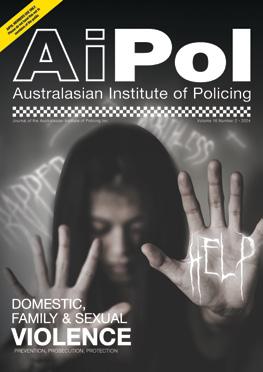
Contributions
Articles on issues of professional interest are sought from Australasian police officers and police academics. Articles are to be electronically provided to the Editor, aipoljournal@aipol.org. Articles are to conform to normal academic conventions. Where an article has previously been prepared during the course of employment, whether with a police service or otherwise, the contributor will be responsible for obtaining permission from that employer to submit the article for publication to Australasian Policing.
Contributors are expected to adhere to the Journal’s publishing guidelines. These guidelines are available in this Journal. All papers are peer-reviewed.
Disclaimer
While every effort is made to check for accuracy, the Publishers or Editors cannot be held responsible for the content, errors or omissions inadvertently published in articles and advertisements in Australasian Policing. Views expressed by contributors are not necessarily those of AiPol, the Editors or the Publisher. No responsibility for loss occasioned to any person acting, or refraining from acting, as a result of material in this publication can be accepted.
Copyright
All rights reserved. No part of this publication may be reproduced or transmitted, in any form or by any means, electronic, mechanical, photocopying, recording, or be stored in any retrieval system of any nature, without written permission of the copyright holder and the Publisher, application for which in the first instance should be made to the Publisher for AiPol.





























































































Editor, Senior Researcher at the Charles Sturt University

Dear Readers
Welcome to this issue of AiPOL. From multiple perspectives it is a tragic reflection on our global society that child sexual abuse in any form exists and is at the centre of a constant battle ground between perpetrators and police/law enforcement agencies.
The arrival of the Internet of Things, and particularly the relative ease of access to the world wide web and associated technologies was heralded as one of the most significant advances for humanity. As we witness decades later, such technological developments whilst advancing humanity have also enabled new crime typologies to emerge and in parallel abuse of our most vulnerable members of society and burgeoning growth of criminal activity, locally, regionally and internationally.
There is a significant depth of research and publications devoted to developing an understanding of the constant emergence of aspects associated with child exploitation. This issue is devoted specifically to drawing together key studies that outline the integral elements of Live Streaming of Child Sexual Abuse (LSCSA), insight

“Police agencies across Australia have made significant inroads in their rapid response to the emergence of LSCSA within the criminal fraternity and as their work continues more information about this form of child sexual abuse and the tools and resources required to combat it will come to light.”
into the extent (as we know it) of this criminal activity and the response by police and law enforcement agencies to combat current and future manifestations of this crime. All of the articles in this edition speak to the difficulty of tracing/ tracking of LSCSA activity due in part to the affordance of the internet to enable subversive activity (often involving complex encrypted platforms) and the factors which contribute to the vulnerability of LSCSA victims – poverty being a significant contributing factor. As explained in the article by Christensen and Woods (Page 8) we are only at the beginning of understanding this crime typology, the catalysts, the characteristics of perpetrators, offences and victims. As our knowledge increases in respect of aspects of LSCSA, police are achieving successful operational outcomes in the investigation of alleged LSCSA activities and the arrest of alleged offenders as discussed in the AFP.gov.au media release ‘Operation Arkstone’.
The article from the Australian Institute of Criminology led by Dr Timothy Cubitt, offers a comprehensive explanation of LSCSA and in particular the characteristic differences between live streaming
and static child sexual abuse and the consequences for policing this crime. Whilst the article by Dr Cubitt provides an excellent insight into aspects associated with LSCSA offending, the article also reflects the generally agreed perspective that there is an urgent need for further research to better understand, for example, the predisposition characteristics of offenders and victims. Such research offering support to the policing endeavours in this area of criminal offending.
As Jonathan Hunt-Sharman discusses, an element that has the potential to support a comprehensive co-ordinated approach to this area of criminal activity is the alignment of legislation within Australia to address LSCSA offending – potentially inclusion of more significant and far-reaching forfeiture schemes.
Police agencies across Australia have made significant inroads in their rapid response to the emergence of LSCSA within the criminal fraternity and as their work continues more information about this form of child sexual abuse and the tools and resources required to combat it will come to light.



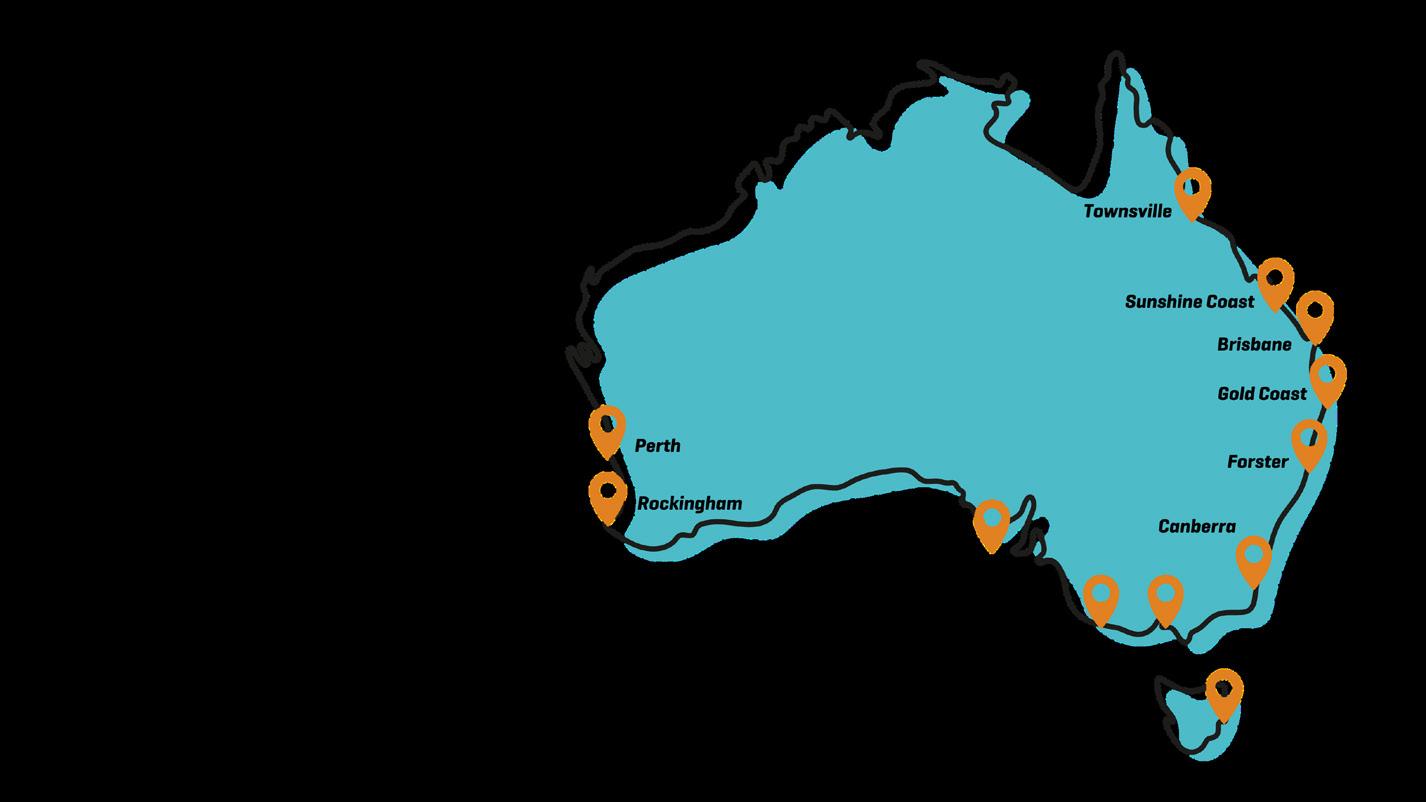

JONATHAN HUNT-SHARMAN

that could have been focused on rescuing real child victims.
Due to the sheer volume of the material being investigated, with a significant number of images being generated overseas, the workload of identifying Child Abuse Material (CAM) and Child Sexual Abuse Material (CSAM) is immense.
It is sadly understandable that CAM and CSAM is largely generated in third world countries where the value of human life is insidiously traded as a commodity by organised crime groups, often with the support of family members. The Philippines has been identified as the exploitation hub of CAM and CSAM and this consumes a large amount of policing resources across the world.
Many of the Australian charges laid relate to Australian individuals in possession of CAM and CSAM generated from overseas.
Prosecution of such a large number of offenders for possession of CAM and CSAM on one hand is a great success story for law enforcement and the community, but on the other, may be hindering police from identifying the insidious crime of Live Streaming Child Sexual Abuse (LSCSA) within Australia.
The ACCCE does successfully identify, investigate and prosecute Australian offenders that have produced or participated in LSCSA. In these cases, there is no excuse that such action was as a result of extreme poverty, desperate family financial situation, physical survival in a third world country. This Australian scum are self satisfying perverted offenders.
These Australian offenders achieve gratification through participating in a horrifying interconnected web of child abusers who take videos and photographs of themselves sexually abusing children, swapping the content with other paedophiles on commonly used social media platforms including Snapchat, Kik, TikTok in addition to the DarkWeb.
Unfortunately, LSCSA is difficult to identify, investigate and prosecute because those involved are hiding behind complex encrypted platforms. However, because LSCSA is real time sexual abuse, there is a potential to stop the abuse and rescue the child whilst the abuse is still occurring, which is not normally the case with CAM and CSAM. Investigative resources directed towards LSCSA are time critical.
Due to the nature of LSCSA and that it can involve Australian children being sexually abused by Australian offenders, the full force of the Australian laws should be focused on identifying, investigating and prosecuting those offenders involved in LSCSA.

Commonweath legislators should consider specific offences relating to LSCSA. Some of which could be modelled on the Northern Territory (NT) scheme under which the property of a person declared to be a drug trafficker can be forfeited. Under that scheme, all of a drug trafficker’s property may be forfeited even if the property is not crimeused or crime-derived. The scheme was challenged, however the High Court’s finding that the scheme did not acquire property otherwise than on just terms, opens the way for the Commonwealth’s forfeiture scheme to be amended to ‘Dove-tail’ with offences specifically related to LSCSA.1
Advocacy for specific legislation for Live Streaming Child Sexual Abuse convictons should include but not be limited to:
§ a Mandatory Sentencing regime2;
§ an asset confiscation scheme similar to the Northern Territory forfeiture scheme, where all assets of the offender can be seized under the Misuse of Drugs Act (NT) (MoD Act) and Criminal Property Forfeiture Act (NT) (CPF Act);
§ a substantial Financial Reward scheme established by the Australian Government for whistleblowers, where it leads to successful prosecution of an offender/s; and
§ whistleblowers to be provided safety and security if they agree to testify in Live Stream Child Sexual Abuse criminal cases, enabling them to provide vital evidence without fear of retribution (eg AFP Witness Protection Scheme).
1 NT forfeiture scheme is established by the Misuse of Drugs Act (NT) (MoD Act) and Criminal Property Forfeiture Act (NT) (CPF Act). Under s 36A(3) of the MoD Act, the NT Supreme Court (on the application of the NT Director of Public Prosecutions) must declare a person to be a ‘drug trafficker’ if they have convictions for offences of a specified kind.
2 Mandatory sentencing regime directs courts as to how they must exercise their sentencing powers. These laws require offenders to be automatically imprisoned - or in some cases detained - for a minimum prescribed period for particular offences.

Building connection and comradery
R U OK? has launched a new podcast series to encourage life changing conversations, early intervention and supportive behaviour amongst the peers, family and friends of those who work and volunteer in the police and emergency services.
The ‘Are They Triple OK? podcast’ features personal stories and practical tools to increase social support for emergency services personnel and build a mentally healthy workplace. It also includes tips on how to ask, ‘are you OK?’ and navigate a conversation if someone is not OK.
Episode one features James Maskey, a retired front-line Queensland Police O cer. In 2013, James was diagnosed with Post Traumatic Stress Disorder.
“As first responders historically, we talk about everything except for mental health and, importantly, suicidal thoughts,” said Mr Maskey. “Either because we didn't have the confidence to have that conversation, or we were worried
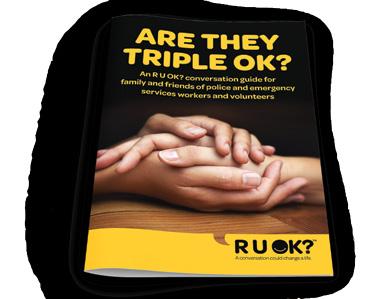
about the impacts of having that chat. And when I say we, I'm talking about me. Certainly, that was my experience.”
Mr Maskey says frontline first responders, in the fire truck, in the ambulance, in the patrol car, have a unique opportunity to get to know their colleagues.
“You know what they like to eat, their co ee order and what their family and their children are up to,” he said. “You know the intimate details of their lives because you've got a long time in the car sitting side by side to share so many experiences.”
Mr Maskey is now the National Sector Specialist at Fortem Australia, and is passionate about enhancing the mental, physical and social wellbeing of the first responder community.
“My advice to the emergency services community is to learn how to have an R U OK? Conversation and start having them,” he said. “If someone is struggling, reaching out for help can feel like a heavy thing to do, it can be a hard task and it can feel overwhelming.

“But when you take the time to ask someone how they’re travelling, you can take some of the weight o and some of the burden away. People are often relieved to have a conversation and feel that level of camaraderie.”
The ‘Are They Triple OK? podcast’ is hosted by Matt Newlands, R U OK? Community Ambassador and former police o ce and is one of a suite of free resources available from
R U OK? for those who work in the police and emergency services, their families and friends. The podcast and resources including a conversation guide and personal stories that demonstrate the life changing impact of an R U OK? conversation can be found at ruok.org.au. The ‘Are They Triple OK? podcast’ will also be available for download on a range of streaming services, including Apple Podcasts, Spotify, Google Play and Audible.
‘Are They Triple OK?’ was developed in response to the Beyond Blue nationwide ‘Answering the call’ survey which found more than half of all police and emergency services employees indicated they had experienced




a traumatic event that had deeply a ected them during the course of their work. Positively, personnel with higher levels of social support and resilience reported lower levels of suicidal thoughts and behaviours.
“The results from ‘Answering the Call’ showed us that the support of peers, family and friends does make a di erence for those who work in frontline services. It’s OK to not be OK. It’s OK to lean on each other, and it’s OK to retire that unhelpful stereotype of being that six-foot bulletproof superhero,” said Maskey.
“I would urge leaders to explore vulnerability to share their own story if they have one, or to support others to share their own story as well. We know that this helps in demystifying mental health."
If you’re worried about someone and feel they need professional support, encourage them to contact their Employee Assistance Program (EAP), appropriate agency support service or connect with a trusted health professional, like their local doctor.
Pinnacle Charitable Foundation is a Funding Partner of R U OK? and is proud to fund the ‘Are they Triple OK?’ campaign.
Specialised wellbeing and mental fitness support for first responders and their families can be accessed through Fortem Australia at fortemaustralia.org.au.
For 24/7 for crisis support call Lifeline on 13 11 14 Text support is also available: 0477 13 11 14
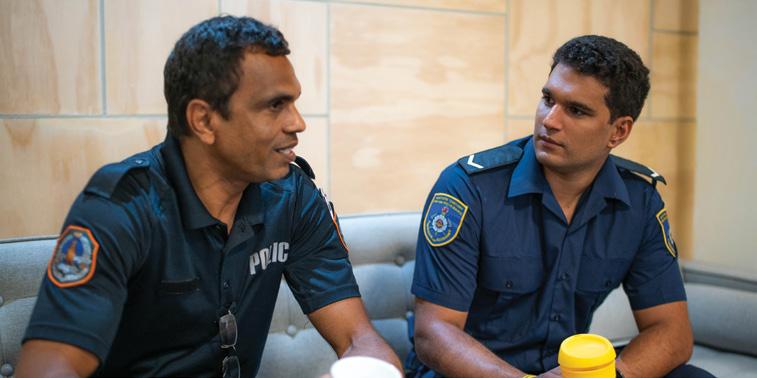



“It’s
The live-streaming of child sexual abuse is an established, and prolific, form of abuse, with high international demand.
9 January 2024

Abstract
The live-streaming of child sexual abuse is an established, and prolific, form of abuse, with high international demand. It involves transmitting the sexual abuse of children in ‘real time’ via a webcam to individuals in any geographical location. Despite it being identified as a global key threat in the area of child sexual exploitation, there is a dearth of literature on this type of offending, limiting our understanding. Until further research is conducted, the current paper fills an important purpose by offering a stop gap of current research on the live-streaming of child sexual abuse. In particular, it draws from a breadth of literature to offer a synthesis of where geographically CSA live-streaming appears to mostly occur; the technological and legal barriers in detecting and prosecuting the behavior; what we know about viewers; what we know about facilitators; and the victims of CSA live-streaming and the impact of the abuse on them. In doing so, this paper offers critical knowledge for research, policy, and practice professionals across psychology, criminology, and law disciplines, who are interested in understanding, preventing, and responding to this form of sexual offending against children.
Most social media platforms have the capability for live-streaming, which includes video call software (Drejer et al., 2023). Originally, web cameras were required for live-streaming but due to developments in technology, anything can be live-streamed with a network connection and a camera such as mobile phones, cameras on computers, professional cameras, right through to the ‘internet of things’ such as drones, glasses, and watches (Drejer et al., 2023). Over recent years, from a user perspective, live-streaming has improved in video quality, greater accessibility, and fewer delays (Drejer et al., 2023). However, live-streaming has a very dark side, such as the livestreaming of child sexual abuse (CSA). As technology continues to develop, the live-streaming of CSA has the potential to, therefore, proliferate.
While the distribution of child sexual abuse material (CSAM) has been around for decades predating the internet, the live-streaming of CSA is considered a new form of exploitation (Malby et al., 2015). It is difficult to ascertain when livestreaming of CSA commenced, however, live-streaming platforms have been available to the public since the early 2000s (Brown et al., 2020), suggesting its presence since this time. Despite its somewhat recent emergence, the livestreaming of CSA appears to be common (Napier et al., 2021a) with reports of a sharp rise in this type of offending (Hernandez et al., 2018). In fact, the live-streaming of CSA is considered
by the Internet Watch Foundation (IWF, 2018) to be an established form of abuse of serious concern, with high global demand (Terre des Hommes, 2013a).
Despite its proliferation, we do not know much about this form of abusive behavior. In fact, there is a lack of empirical research on the characteristics of offenses, offenders, and victims (Napier et al., 2021a). This is problematic when Europol (2016) has identified the live-streaming of CSA as a key threat in the area of child sexual exploitation. The dearth of literature means there is limited understanding of this type of offending (Cubitt et al., 2021). Most of the research in the CSAM field has focused on passive platforms, such as websites, that distribute CSAM. There is limited research exploring active platforms that transmit the material through livestreaming. Given this area of research is only in the early stages of gathering data and knowledge (Drejer et al., 2023), the current paper offers a stop gap of current research on CSA live-streaming, including: where geographically CSA live-streaming appears to mostly occur; the technological and legal barriers in detecting and prosecuting the behavior; what we know about viewers; what we know about facilitators; and the victims of CSA live-streaming and the impact of the abuse on the victims. We do not want to overstate the contribution of the current synthesis of literature as it does not offer a systematic review given the dearth of research in the field, however, it still offers critical knowledge for psychology, criminology, and law disciplines.


In particular, a synthesis allows us to, “take stock of what we know” and has the potential to yield new knowledge based on combinations of existing information (Carpenter et al., 2009, p. 699).
Live-streaming involves broadcasting the sexual abuse of children in real time over a webcam to individuals in any geographical location (End Child Prostitution in Asian Tourism [ECPAT] International, 2017a). The key difference between CSAM distribution and the live-streaming of CSA is the ‘real time’ aspect (Brown et al., 2020). The livestreaming of CSA is a form of human trafficking (Child Rescue Coalition, 2023). Human trafficking is defined by several conventions and is generally composed of three components: act, means, and intent (United Nations, 2000). The act refers to what is done (e.g., recruiting); the means refers to how the act is done (e.g., deception, force, threat); and intent is why it is done (e.g., profit, sexual exploitation) (United Nations, 2000). The live-streaming of CSA has also been referred to as ‘webcam child sex abuse’, ‘child sexual abuse to order’, ‘webcam child prostitution’, ‘webcam child sex tourism’, and ‘live-distance child abuse’ (Açar, 2017; AUSTRAC, 2019; Dushi, 2019; Masri, 2015; Terre des Hommes, 2013a).
The viewer (‘handsoff’ offender) typically gains access through facilitators or intermediaries (ECPAT International, 2017b). A time and date are agreed on between the viewer and facilitator, along
with a price (ECPAT International, 2017b).
The ‘show’ is often organised by a facilitator in a private place where children are made to follow instructions from the remote viewer to perform sexual acts (Hernandez et al., 2018). These requests typically occur prior to, or during, the live-streaming (Brown et al., 2020), with the viewer potentially directing and orchestrating the offending in real time (Europol, 2019). The child may engage in sexual acts by themselves, or the abuse might involve other children or adults (ECPAT International, 2017a).
The viewer pays the facilitator through some form of a wire transfer or, more recently, Bitcoins or other online money transfer sites (Hernandez et al., 2018).
The price is typically determined by the age and number of children involved, the length of the ‘show’, and the sexual acts involved (Terre des Hommes, 2013a).
In some instances, the live-streaming is even recorded and disseminated online to generate maximum profit (Malby et al., 2015), therefore contributing to the pool of CSAM available globally.
Data on human trafficking for child sexual exploitation, in general, is unreliable which means that quantifying the extent of any form of child sexual exploitation, including the live-streaming of CSA, is very difficult (Chan, 2010; Davy, 2018; International Justice Mission [IJM], 2013; Kaneti, 2011; Morrish, 2011). While the Philippine Government is making significant efforts to improve the policy, legal, and institutional
framework with the view of protecting children against the many forms of sexual abuse, exploitation, and sale of children (United Nations, 2022), the Philippines is considered a main global source of CSAM (Hernandez et al., 2018) and the center for the live-streaming of CSA (ECPAT International, 2017a; Europol, 2019). Some factors related to this are the country’s inequality and poverty, high levels of internet connectivity, and proficiency in English (Kuhlmann & Aurén, 2015). However, Kuhlmann and Aurén (2015) acknowledge that these factors are not completely different from other regions (e.g., poverty and inequality are also found in other regions and therefore cannot be the sole reason).
Children who are forced into performing for live-streams are often coerced into exploitation because of their desperate family financial circumstances (Beazley, 2015; Brown, 2016; Davy, 2017, 2018; Kuhlmann & Aurén, 2015; Terre des Hommes, 2013a, 2013b). That is, when the level of poverty is very high, some parents may resort to prostituting their children (Dushi, 2019). In the Philippines, it was estimated that in 2021, 26.14 million Filipinos were living below the poverty line (Philippine Statistics Authority, 2021), therefore placing children from these families at risk of exploitation. In case studies presented by Brown (2016), it was found that children were asked by parents to perform these acts with the parents claiming that this was not sexual abuse as there was no
continued on page 10

touching involved (indicating parents were not aware that they were violating the law). This is in contrast to Kuhlmann and Aurén (2015) whose research suggested that parents understood the criminal nature of CSA live-streaming and the legal implications. Some families see the live-streaming of CSA as an easy way to make money and this is often the family’s major source of income (Kuhlmann & Aurén, 2015; Terre des Hommes, 2013a).
It has also been determined that cultural factors can lead to children feeling they have a duty to contribute to their family income which can in turn lead to exploitation (Beazley, 2015; Davy, 2017, 2018; Huijsmans, 2008; Terre des Hommes, 2013b). When considering this issue, it is important to understand the impact of the financial gains exploitation can have on the welfare of the family (Beazley, 2015). A child’s early entry into the workforce is commonly a result of poverty however elements of cultural practice also need to be considered, including the regional social construction of childhood, especially among the poor (Beazley, 2015). In 2006, India banned the employment of children under the age of 14 as domestic workers or in related work, however, there was criticism that this would result in half a million children being out of work, and were deemed at risk of exploitation due to the necessity to assist with providing the family income (Bourdillon, 2009).
It is acknowledged that in Southeast Asia, families experiencing financial hardships do not regard children as dependents. The children are expected to work and supplement the family income, rather than being protected from the difficult economic conditions their parents face (Beazley, 2015; Bourdillon, 2009; Terre des Hommes, 2013b). Children experiencing poverty have fewer opportunities to generate income or economic security, placing them in jeopardy of entering into highrisk arrangements or agreements, increasing their vulnerability to child sexual exploitation (Apland & Yarrow, 2019; Brown, 2016; Davy, 2017; Terre des Hommes, 2013b).
However, we recognise that not all live-streaming cases occur only in developing countries facing great economic hardship. For example, in the United States, a mother was jailed for two and a half years, for making her
10-year-old daughter pose nude for a stranger over a webcam (Seales, 2012). In a different case, a 33-year-old woman from the United Kingdom received a sixyear sentence after live-streaming herself sexually abusing a young girl, along with other related offenses (Menendez, 2019). While there does appear to be an element of financial gain for these cases, these occurrences show that this issue is not exclusively limited to developing countries.
Live - Streaming of CSA
The technological and legal barriers associated with detecting and prosecuting the live-streaming of CSA have been noted (Açar, 2017). First, in terms of technological barriers, live-streaming is considered to present great challenges to law enforcement (Açar, 2017; Christensen et al., 2015; ECPAT International, 2017a), with it being difficult to disrupt and detect (Cubitt, 2023). Particularly with end-toend encryption and mostly anonymous payment systems (Europol, 2016), the surveillance of transferred content is impeded. In some situations, there is no evidence sexual crimes via live-streaming have even occurred (Christensen et al., 2015), aside from call times and some money transfers (ECPAT International, 2018). Live-streaming platforms typically involve usage policies that outline the acceptable uses of the streaming platform, but it is an almost impossible task to regulate content that is occurring in real time (Horsman, 2018a). As such, content that breaches the terms and conditions can still occur on such platforms (Horsman, 2018a).
Further to this crime being a financially enabled crime type it is also a technologically enabled crime type (Cubitt et al., 2021; Europol, 2019). New technologies have enabled the live-streaming of this abuse (Cubitt et al., 2021). Due to the ever emergent applications and programs, law enforcement will not always have the technology to identify and prosecute these crimes (Christensen et al., 2015). While these offenses have certain characteristics – payments sent to weaker countries, small amounts of money, and the use of remittance services – individually, these are not a
strong sign that live-streaming has taken place (Napier et al., 2021a). Further, the emergence of various types of finance has resulted in difficulties policing this crime (WeProtect Global Alliance, 2019), with Europol (2016) noting they expect to see an increase in anonymous payment systems. However, there is the potential for questionable transactions to be flagged when using sophisticated techniques such as machine learning (Napier et al., 2021a).
In addition to the difficulty in being able to detect the abuse from the outside (e.g., for law enforcement) given it is occurring in a secured environment that often involves an encrypted connection, it is also difficult to find concrete evidence of the live case (Drejer et al., 2023). However, one way to investigate the content is by reviewing cached content on the devices (as viewing the live-stream results in cached content), and rebuilding from the cached stream (Drejer et al., 2023; Horsman, 2018b, 2019). Further to the cached content, browsing history also needs to be considered to allow for proper investigations (Drejer et al., 2023). However, modern browsers now have the option of “private mode” which poses a barrier, with evidence being automatically deleted or not accessible (Drejer et al., 2023). There have also been additional security features added by companies (Açar, 2017) given the privacy concerns of consumers (Rainie & Madden, 2015). While several futuristic methods of detection have been proposed (see Açar, 2017), there is still a long and rough way to go in being able to deter and detect possible offenders (Açar, 2017). In short, there are currently great technical complexities that make it difficult to use a general and lawful interception regime (Açar, 2017), along with challenges in creating rules, legislation, and laws that balance the principles of privacy (Drejer et al., 2023).
There are several legal limitations associated with prosecuting the livestreaming of CSA. First, this form of CSA is not criminalised explicitly in international legal frameworks on the topic of sexual exploitation (ECPAT International, 2017b). Weak laws in poorer countries pertaining to child protection is also another factor driving the live-streaming (Dushi, 2019). Most of the leads come from law enforcement agencies overseas, as opposed to local leads (Brown, 2016), and crossborder collaboration is an
issue with the diverging legal terms and definitions (Drejer et al., 2023). Or other complexities can emerge. For example, Johnson et al. (2020) identified that the Cambodian legislation is largely based on the Law on Suppression of Human Trafficking and Sexual Exploitation, thereby meeting international standards, however, there is no strong direction on which instrument (e.g., royal decrees, subdecrees, Prakas (guidelines/ regulations), decisions, policies, guidelines, minimum standard) takes precedence when they are in conflict. The lack of harmonisation in addressing livestreaming can result in legal loopholes (Drejer et al., 2023). Greater collaboration between law enforcement and industry is required when it comes to disrupting CSAM, including live-streaming, given the array of services and platforms used (Edwards et al., 2021).
As Edwards et al. (2021, p. 12) state, “no organisation, whether technical or law enforcement, can operate in isolation.”
There is limited prevention, with some suggesting governments have not done enough to detect and prosecute offenders (Dushi, 2019). The individual offense of live-streaming CSA does not appear to be captured adequately in legislation (Dushi, 2019). If live-streaming is detected, it is typically the other offenses that take place alongside the live-streaming that are criminalised (e.g., CSA, child prostitution, and CSAM offenses) instead of the livestreaming in and of itself (Dushi, 2019). There have been calls for harmonised legislation at a global level to improve multijurisdictional investigations, particularly (ECPAT International, 2020). Without such legislation, “safe havens” will continue in those countries that have more relaxed legislation (ECPAT International, 2020).
There is a paucity of research on the characteristics of these offenders (Cubitt et al., 2021). CSA live-streaming viewers appear to be a homogenous group (Cubitt et al., 2023). While victims are often (but not exclusively) from developing countries, these ‘hands-off’ offenders, or ‘customers’, are typically from developed countries (ECPAT International, 2020). Research by IJM (2020) found that of the offenders using live-streaming, 34% were from the United States, 25% from Sweden, and 18% from Australia. Offenders were also located in Canada, Ireland,
Israel, the Netherlands, Norway, and the United Kingdom (IJM, 2020).
In a study that utilised financial transaction data, Brown et al. (2020) found individuals who purchased livestreaming had an average age of 54 years at the time of purchase, with twothirds aged between 50 and 69 years (youngest = 20 years, oldest = 76 years). This age differs significantly from CSAM offenders (late thirties or early forties; Babchishin et al., 2011; Christensen & Tsagaris, 2020) and individuals who perpetrate contact sexual offenses (average age of 43.6 years; Babchishin et al., 2011). This indicates that CSA live-streaming offenders are an older cohort than CSAM offenders and contact offenders which could have implications for prevention strategies and responses.
Brown et al. (2020) also found most offenders had no criminal history (55%), while the others had a sexual offense history against children (6.6%), adults/ unspecified victims (5.5%), or other offenses (44.5%). Compared with the other two groups (no criminal history and other offenses), those with a sexual offending history were significantly more likely to have made multiple transactions (Brown et al., 2020). Occupations varied, with some occupations including aged care worker, accountant, tradesperson, architect, and computer technician, with one individual classifying themselves as a housewife (Brown et al., 2020). In their analysis of the characteristics of 209 individuals who engaged in the live-streaming of CSA, Cubitt et al. (2023) found most offenders exclusively engaged in this type of offending, with most of the sample having little to no criminal history. Only a small subgroup committed violent and contact sexual offenses. Aside from this subgroup, CSA live-streaming offenders appear to be specialists in the victimisation of children online (Cubitt et al., 2023).
We know that the internet allows for a criminogenic environment, with it deemed a ‘Triple-A Engine’; accessible, affordable, and anonymous (Cooper, 1998). This is seen in the live-streaming of CSA, with it considered to be cheap, easy to access, and less risky compared with traditional forms of child prostitution (Dushi, 2019). Therefore, livestreaming may be appealing to viewers in developed countries, as not only is it


The lack of harmonization in addressing live-streaming can result in legal loop-holes (Drejer et al., 2023).

low cost, but the offender surpasses the risk of sexually abusing the children in a physical way (Brown et al., 2020) and has the anonymity of end-to-end encryption. But there might come a point where the offender ends up escalating in their offending behavior. Until recently, it was unknown whether these individuals who engage in CSA live-streaming escalate in offending over time (Brown et al., 2020). However, Brown et al. (2020) found evidence for potential escalation; as the number of transactions increased, the average time between transactions decreased. They also found the median price offenders paid for services increased by the number of transactions. That is, they found escalation in the amounts paid and frequency of CSA live-streaming (Brown et al., 2020).
Cubitt et al. (2021) similarly found CSA live-streaming transactions were about twice as often and closer together for the high-volume offenders compared with low-volume offenders.
Further to the escalation of CSA livestreaming in and of itself, there may be the potential for the offender to escalate to other types of related offenses. This is a reasonable proposition when studies on CSAM offenders have found some individuals escalate in their offending to contact offenses. For example, Quayle and Taylor (2003) found contact offending to be an extension of CSAM offending. In a different study that applied Ward and Siegert’s (2002) pathways model to sexual offending, the researchers found some offenders who had engaged in penetrative offenses against children had engaged in CSAM offending before turning to contact offending (Osbourne & Christensen, 2020). Christensen and colleagues (2021) even argue that those who commence masturbating to virtual CSAM (e.g., drawings, cartoons, animations of child sexual abuse) have the potential to escalate to CSAM material (i.e., involving real children) and even possibly act out sexual drives on children (i.e., contact offending). This might be due to desensitisation; these offenders wanting to experience their initial level of sexual gratification when they first started to engage with the virtual material (Christensen et al., 2021). As Cubitt et al. (2021) recommend, there is a benefit to exploring the possible link between contact sexual offending and those offenders who engage in high-volume CSA live-streaming.
What do We Know About Facilitators? Facilitators are also known as ‘traffickers’ and ‘operators’ and are the individuals that organise the abuse and payment (Brown, 2016; Napier et al., 2021b). According to Terre des Hommes (2013b) the operators are responsible for communicating with foreign online clients as well as recruiting and finding children for the webcam sex shows. They often operate the webcam and may instruct victims on how to act in front of the camera (Terre des Hommes, 2013b). There appear to be different types of facilitators: individual operations which occur in private residences or internet cafes; family run operations involving parents or other family members who coerce their children to perform webcam sex shows; and webcam child sex tourism dens where children are either hired or trafficked and kept against their will to perform webcam sex shows (Terre des Hommes, 2013b). It must be acknowledged that one impact of COVID-19 has been the increase in CSA live-streaming (ECPAT International, 2021). Border closures, restrictions, and closures of hotels and entertainment venues have forced facilitators to move to online child sexual exploitation (ECPAT International, 2021), where such locations may have previously been used for people to travel to and sexually abuse the child themselves. Offenders often form relationships with adults, either online or whilst traveling which then may lead to these adults facilitating live-streaming offenses (Napier et al., 2021b). Alternatively, offenders often ‘spam’ multiple individuals on social networking sites which may lead to these individuals acting as operators of CSA live-streaming offenses (DeHart et al., 2017; Kuhlmann & Aurén, 2015; Napier et al., 2021b). In their study of the characteristics of CSA livestreaming offenders and offenses, Napier et al. (2021b) found facilitators were mostly female and, of known cases, the median age was 20 years. Almost 90% of facilitators were relatives. They were predominantly the victim’s mother, followed by other relatives (i.e., sister, cousin, aunt). Research by Terre des Hommes (2013a) supports these figures stating that a family member or someone known to the children is often responsible for forcing them into webcam sex, and the adults are often the ones to initiate contact with the online foreign offenders. As further research emerges on this offending group, there is the potential for law enforcement and other organisations to look at ways to detect and disrupt these facilitators.
Who are the Victims of CSA Live - Streaming and What is the Impact on These Victims? Few studies have explored victim demographics of CSA live-streaming. One study that reviewed 2,082 files (videos and images) captured from livestreaming found most victims were on their own (96%) and aged 13 and under (98%) with 69% of the imagery depicting children aged between 11 and 13 years of age (IWF, 2018). Alarmingly, 40% were at the greatest levels of abuse severity (Category A or B), with 18% involved in the most serious sexual abuse (Category A; IWF, 2018). Category A involved bestiality, sadism, and penetrative sexual activity (IWF, 2018). Most of the material (96%) depicted one or more girls, as opposed to one or more boys (3%). In only 1% of cases the imagery included two or more children of both genders. This research particularly highlights the gendered nature of the victims involved in live-streaming.
While the IWF (2018) found most victims were aged 13 and under, a study conducted by Terre des Hommes (2013b) found the average age for victims of CSA live-streaming was 16 years old. One reason for this finding could be the time period and the changing landscape of CSA live-streaming with the IWF data covering a more recent period (data from 2017) compared with the Terre des Hommes’ data (data from 2012). However, the exact reason for this is unknown, and highlights the need for further research. Terre des Hommes (2013b) found these victims had the highest education level of grade seven, which was significantly lower than children not involved in CSA live-streaming. Additionally, 53% of children who were victims of CSA livestreaming were from broken homes, with the recurring theme of lack of financial security, and were likely to be victims of physical and emotional abuse (Terre des Hommes, 2013b). The dearth of literature on victims of CSA live-streaming underlines the need for further research in this area. Learning more about the victims will not only assist law enforcement but can also contribute to primary prevention efforts such as tailored awareness-raising initiatives amongst children.
There is a perception amongst parents who coerce their children into participating in live-streaming CSA that their children are not at risk or are not likely to experience negative outcomes, as there is no physical
touching involved; however, this does not account for the emotional harm to victims (Kuhlmann & Aurén, 2015; Terre des Hommes, 2013a). Brown (2016) states that live-streaming CSA may affect a child’s emotional and physical development, impacting their ability to form relationships and increasing the risk of becoming further involved in sex work and becoming abusers themselves. Terre des Hommes (2013b) concurs that harm to victims is substantial and is consistent with contact offenses. While the long-term impacts around the live-streaming of CSA are unknown, the impact of CSA has been well documented (Gill, 2021; Merten, 2020). Studies on the impacts of CSA have shown that children can have delays in cognitive development (Barrera et al., 2013), as well as issues with mental health which can include depression and anxiety and, in some instances, posttraumatic stress disorder (Cashmore & Shackel, 2013; Lindert et al., 2014; Wurtele, 2009). Long-term effects can include issues with physical, psychological, social, and economic wellbeing (Blakemore et al., 2017; Cashmore & Shackel, 2013) as well as vicarious trauma on the suvivors’ families and communities (Blakemore et al., 2017).
In one study, the impacts specific to victims involved in the live-streaming of CSA were documented (see Terre des Hommes, 2013b). Children reported feeling ashamed, worthless, contaminated, fearful of being caught and arrested, and being concerned for their reputation and their family’s reputation (Masri, 2015; Terre des Hommes, 2013b). There were added complexities of family-run webcam sex operations with children reporting conflicting ideas about their parents, particularly if the parents were arrested and the children were called as witnesses (Terre des Hommes, 2013b; Masri, 2015). While some effects on victims have been documented, further studies are required to ascertain the long-term effects regarding the live-streaming of CSA.
While live-streaming has made our lives simpler in many respects, there can be a very dark side to this technology for some users. With the continual development of technology, there is potential for the ongoing proliferation of the live-streaming of CSA. While we know this form of abuse is in high demand (Terre des Hommes, 2013a) and is even considered by Europol (2016) to be a key threat in the area of child
sexual exploitation, little is actually known about this form of abusive behavior. As this field is still in the early stages of gathering data and knowledge (Drejer et al., 2023) the current paper offered a stop gap of the current research on CSA live-streaming. In doing so, we covered: where geographically CSA live-streaming appears to mostly occur; the technological and legal barriers in detecting and prosecuting the behavior; what we know about viewers; what we know about facilitators; and the victims of CSA live-streaming and the impact of the abuse on the victims.
While it appears that CSA live-streaming is most prominent in the Philippines and other developing countries, it must be acknowledged that this finding might simply have emerged as most of the data stems from the Philippines (Drejer et al., 2023). Drejer et al. (2023, p.10) question whether CSA live-streaming actually occurs mostly in the Philippines or “if we are seeing the tip of the iceberg of a globally widespread issue,” highlighting the need for prevalence studies in other geographical locations. The research on technological and legal barriers suggests that live-streaming will continue to present challenges until there is greater collaboration between law enforcement and industry along with harmonised legislation at a global level.
It was interesting to find that offenders appear to be a homogenous group. Most viewers did not have a criminal history and were typically aged between 50 and 69 years (Brown et al., 2020), which is significantly older than CSAM and contact offenders. This could, therefore, have implications for prevention strategies and responses. To provide one example for prevention, pop-up warning messages have been found to be a cost effective and valuable strategy to deter individuals from accessing CSAM (Prichard et al., 2022) and there may be merit in pop-up warning messages potentially being applied in cases of CSA live-streaming. With what we know about viewer age, the warning messages could therefore be written to best target this offending group (50–69 years e.g., deterring individuals from spending early retirement years in prison). We also highlighted the need for further research into the potential for escalation amongst this group of offenders.
Regarding facilitators, while they too appear to be a homogenous group of offenders, research has found them to mostly be female and relatives (Napier et al., 2021b). This highlights the highly

entwined nature of the facilitator(s) and victim(s). The victims of CSA livestreaming mostly appear to be girls aged 13 years and under (IWF, 2018). This research particularly underlines the gendered nature of victimisation of this type of crime. While the impacts of livestreaming CSA are still in their infancy, the long-term impacts of CSA have been well documented. There also appear to be added complexities to the impacts specific to the live-streaming of CSA of family-run web-cam sex operations, again, due to this entwined relationship between the parent(s) and the child(ren). This synthesis highlights the need for research on the long-term effects of this type of offending on victims.
We recognise one major limitation of the current paper is that it did not conduct a systematic review and that at present, there is no defined method available that uses rigorous approaches in non-systematic reviews (Dicks et al., 2017). We therefore acknowledge that the current paper does not offer a completely unbiased, rigorous, and comprehensive assessment of the literature like one might see when following formal systematic review methods (Dicks et al., 2017), but the field is still too premature to conduct a review of this level as the literature is still in the early stages of development. As future work, we are willing to conduct such a review when the research is available. We argue that the current synthesis still advances this underdeveloped field along with its contribution of suggested areas for future research and implications. In doing so, it offers timely and critical knowledge for research, policy, and practice professionals across criminology, psychology, and law disciplines who are concerned about under-standing, preventing, and responding to this form of sexual offending against some of our most vulnerable populations.


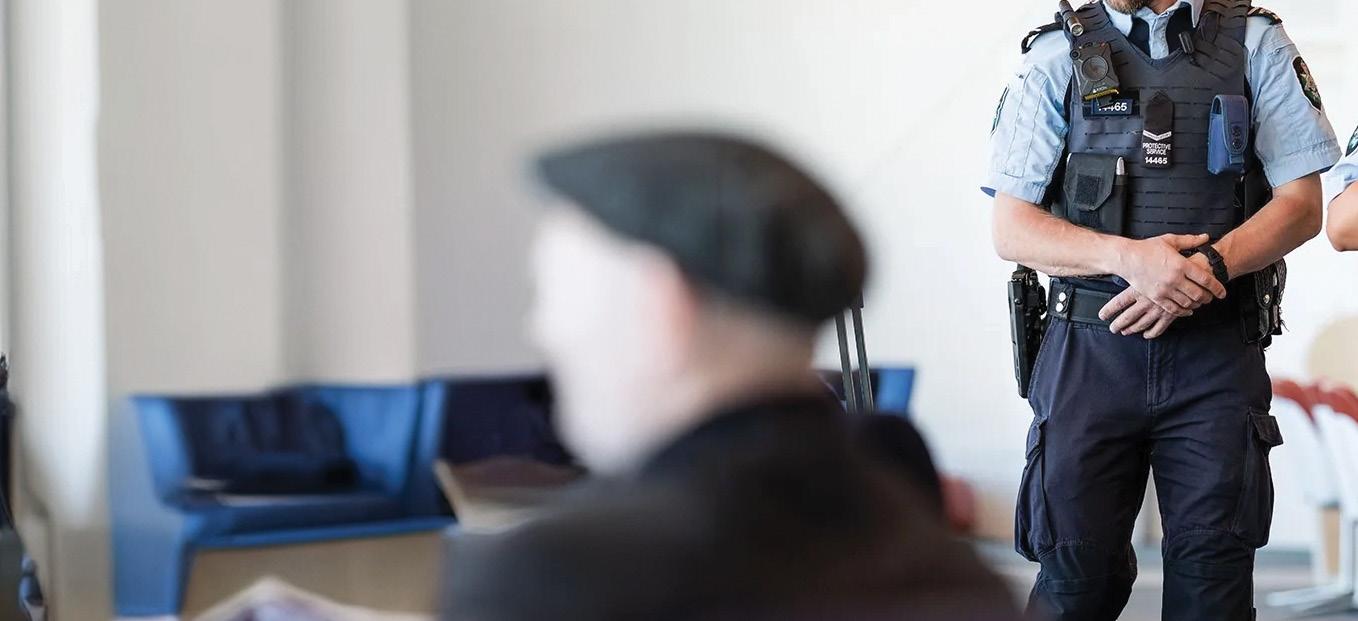
Operation Arkstone results in 1352 charges laid with 56 child victims identified
A large-scale Australian Federal Policeled investigation into a network of alleged child sex offenders has identified 56 Australian victims, including 16 from a child care centre.
New details can be outlined about Australian Federal Police (AFP) Operation Arkstone, which has led to the arrest of 26 men on 1,352 charges of child exploitation, and bestiality charges related to 11 animals.
The alleged offenders are accused of producing and/or sharing child abuse material to an online network of Australian and overseas peers.
AFP investigators have worked tirelessly with their counterparts in New South Wales Police, Queensland Police Service, Western Australia Police, and U.S. Homeland Security Investigation to identify the alleged offenders involved in the online social media forums and stop them from causing further harm to the children depicted in the CAM.
One alleged member of the network, a 27-year-old former child care worker in NSW, was charged with multiple counts of contact offending, including sexual intercourse with a child under 10 years; indecent assault of a children under 16 years, and intentionally sexually touching a child under 10 years. He was facing more than 303 charges. Police allege the man used his position as a child care worker, and other deceptive means in his personal life, to gain access to 30 children. The man's partner, a 22-year-old man, also allegedly abused children his partner accessed through deceptive means in his personal life.

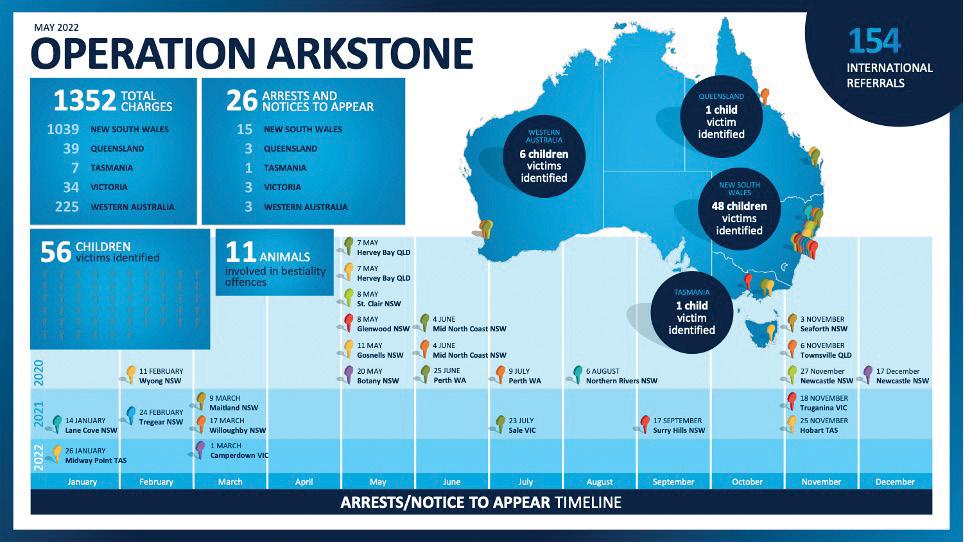
The AFP-led Australian Centre to Counter Child Exploitation (ACCCE) in February 2020 received a report from the US National Centre for Missing and Exploited Children about an online user allegedly uploading child abuse material.
The report led to an investigation by the AFP's Eastern Command Child Protection Operations in Sydney, and a 30-year-old Wyong man was identified. He was arrested in February 2020 was charged with child abuse offences, including alleged contact offending of two children.
Investigators delved further into the man's activities and reviewed electronic evidence seized during the initial warrants. As a result, the AFP discovered social media forums where
some members were allegedly producing CAM, while others were accessing and circulating the material.
Evidence gathering at each arrest led to the unravelling of this alleged online network – each warrant led to the discovery of more alleged offenders and more children to be saved from ongoing abuse.
It sparked Operation Arkstone, which was set up to identify and arrest each of these alleged offenders trading material on these forums. Since then, the investigation into the online forums continued, with each arrest and analysis of the evidence finding connections to other alleged child sex offenders and more child victims to identify and remove from further harm.
The alleged offenders ranged in age from 20 to 48 years, with an average


age of 28 years. The positions of the alleged offenders varied from a child care worker, volunteer soccer coach, disability support worker, through to an electrician, supermarket employee and chef.
The child victims ranged in age from 16 months to 15 years, with an average age of eight years.
Operation Arkstone investigators identified links through the online forums to alleged child sex offenders residing in Europe, Asia, United States and Canada, and New Zealand, with 154 international referrals made as a result of this investigation. Investigators are continuing to examine the evidence and have not ruled out further arrests.
AFP Acting Commander Child Protection Operations Christopher Woods said the scale of offending uncovered in the Operation Arkstone network was unprecedented in an AFP-led operation.
"No child should be subjected to abuse and violence from people who hold high positions of trust in their lives, whether it be a family member, child care worker or soccer coach. What this highlights is that offenders are across age groups, occupations and are in positions of trust. Parents need to be vigilant about who has access to their children."
Police allege Operation Arkstone revealed a network of abuse, where the alleged offenders in the forums encouraged and emboldened each other to engage in acts of depravity and abuse of children. These offenders allegedly produced child abuse material for the depraved pleasure of their peers with absolutely no thought to the lasting effects their actions would have on these children.

“New details can be outlined about Australian Federal Police (AFP) Operation Arkstone, which has led to the arrest of 26 men on 1,352 charges of child exploitation, and bestiality charges related to 11 animals.”

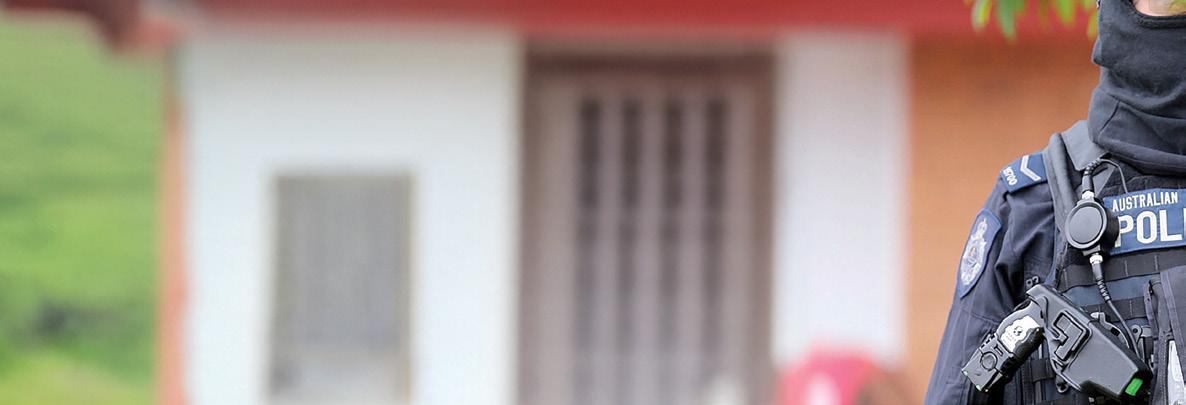

20 July 2021
A 30-year-old Wyong man who sparked the nationwide operation into the international child abuse network was sentenced to 18 years imprisonment by the Gosford District Court.
The man had previously pleaded guilty to 17 offences including sexual touching of a child under 10, committing sexual acts against a child under 10 and possessing, producing and disseminating child abuse material.
Australian Federal Police (AFP) Eastern Command Child Protection Operations officers arrested the man in February 2020 after the AFP-led Australian Centre to Counter Child Exploitation (ACCCE)
received a referral from the United States.
The report from the National Center for Missing and Exploited Children (NCMEC) contained information on a Snapchat user who was uploading child abuse material.
Enquiries by investigators linked the 30-year-old man to the social media account and a search warrant was executed at his Wyong home in February last year. Evidence seized during the warrant, including a laptop computer and mobile devices, linked the man to an online network of men across Australia who were sharing child abuse material.
In August 2020 investigators laid an additional 80 charges against the man
relating to the abuse of a child known to him, and the sharing of this material online. The 30-year-old man received a non-parole period of 12 years.
AFP Federal Agent Scott Veltmeyer said numerous teams in the AFP, with the assistance of State and Territory police and international partners, have been working diligently to identify offenders and victims from each new piece of information that has come to light.
“We’re pleased to have dismantled this network but it is truly heartbreaking that Australia is not immune to this heinous crime,” Federal Agent Voltmeter said.

A 33-year-old Townsville man who is connected to the international online child abuse network received a maximum two year jail sentence by the Townsville District Court on 10 February 2022.
The Brisbane Joint Anti-Child Exploitation Team arrested the man at his home in Mundingburra on 6 November 2020, following an Operation Arkstone investigation into child abuse videos shared through a messaging application.
The man pleaded guilty to seven charges in August 2021:
§ One count of solicit child pornography material, contrary to section 474.19(1) of the Criminal Code (Cth);
§ Two counts of indecent treatment of a child under 16, under 12, contrary to section 210(1) (d)&(3) of the Criminal Code 1899 (Qld);
§ Two counts of involve child in making child exploitation material, contrary to section 228A of the Criminal Code 1899 (Qld); and
§ Two counts of use carriage service to transmit child abuse material, contrary to section 474.22(1) of the Criminal Code (Cth).
He was eligible for parole on 10 August 2022, due to state and Commonwealth terms of imprisonment being served concurrently.

Editor’s Note: Latest Operation Arkstone infographic is available via hightail
A 33-year-old Townsville man who is connected to the international online child abuse network received a maximum two year jail sentence by the Townsville District Court on 10 February 2022.


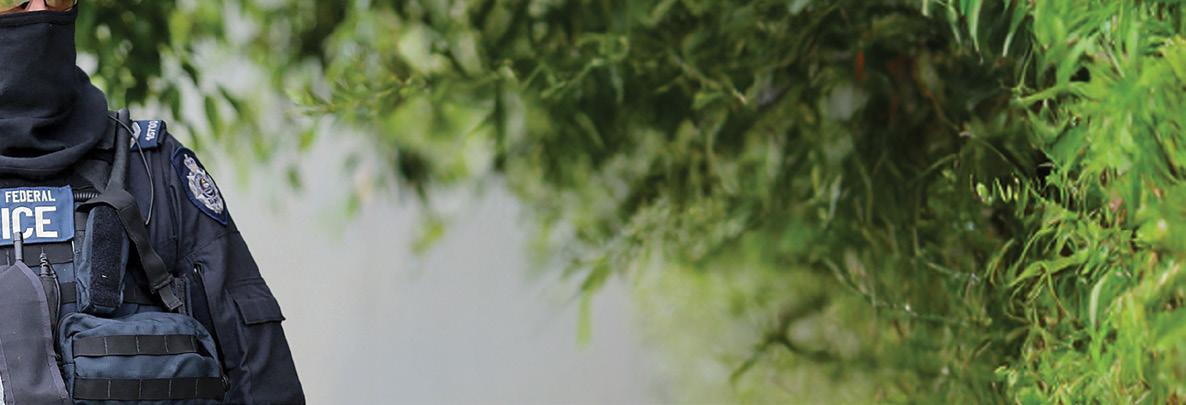
13 May 2022
A 31-year-old Western Sydney soccer coach was convicted on 13 May 2022 of sexually assaulting seven children and sentenced to 30 years in jail at Downing Centre District Court.
He was arrested during a search warrant on 8 May 2021 after being linked to an online child abuse network. He admitted to sexually assaulting seven children in his care over at least three years, and to producing and transmitting child abuse material.
In July 2021, he pleaded guilty at Central Local Court to 179 child abuse charges, including 26 carrying a maximum penalty of life imprisonment. He will be eligible for parole after 22 years.


14 December 2022
A 29 year old Sydney man was sentenced to 17 years and four months’ imprisonment in the Gosford District Court after the AFP investigation revealed the man sexually abused three children. AFP Eastern Command Child Protection investigators executed a search warrant on 24 February 2021, at the man’s Tregear home, where they seized mobile phones containing child abuse images and videos.
A forensic examination of the phones revealed self-produced child abuse material, where the man had taken images and videos of himself sexually abusing children. He also shared the abuse material with others through instant messaging applications. The man pleaded guilty to 12 child abuse charges and one bestiality charge on 19 August 2022.
§ One count of sexual intercourse with a child

Editor’s note: Vision of the arrest, audio grabs of Acting Sergeant Scott Veltmeyer and an infographic of Op Arkstone are available via Hightail
In July 2021, he plead guilty at Central Local Court to 179 child abuse charges, including 26 that carried a maximum penalty of life imprisonment.

under 10, contrary to section 66A of the Crimes Act 1900 (NSW);
§ One count of sexual intercourse with child between 10 and 14, contrary to section 66C(1) of the Crimes Act 1900 (NSW).
§ Three counts of indecent assault child under 16 years of age, contrary to section 61M(2) of the Crimes Act 1900 (NSW); continued on page 18


§ One count of incite a child above the age of 10 years and under the age of 16 years to sexually touch his person, contrary to section 66DB(b) of the Crimes Act 1900 (NSW);
§ One count of meeting a child under 14, following grooming for sexual purposes, contrary to section 66EB (2A) of the Crimes Act 1900 (NSW);
§ Two counts of use child for the production of child abuse material, contrary to section 91G of the Crimes Act 1900 (NSW);
§ One count of attempt to commit bestiality, contrary to section 80 of the Crimes Act 1900 (NSW);
§ One count of possess or control child abuse material obtained or accessed using a carriage service, contrary to section 474.22A of the Criminal Code 1995 (Cth);
§ Two counts of using a carriage service to transmit child abuse material, contrary to section 474.22(1)(a)(iii) of the Criminal Code 1995 (Cth); and
§ One count of using a carriage service to solicit child abuse material, contrary to section 474.22(1)(a)(iv) of the Criminal Code 1995 (Cth).
§ The following six charges were also taken into account during the man’s sentencing.
§ Two counts of commit an indecent act with or towards a person under 10, contrary to section 61O(2) of the Crimes Act 1900 (NSW);
§ One count of use child above 14 years for the production of child abuse material, contrary to section 91G(2)(a) of the Crimes Act 1900 (NSW);
§ One count of sexual intercourse with child between 10 and 14, contrary to section 66C(1) of the Crimes Act 1900 (NSW);
§ One count of using a carriage service to transmit indecent communication to a person under 16, contrary to section 474.27A(1) of the Criminal Code 1995 (Cth); and
§ One count of using a carriage service to transmit child abuse material, contrary to section 474.22(1)(a) (iii) of the Criminal Code 1995 (Cth).
He was sentenced to 17 years and four months’ imprisonment with a non-parole period of eight years and 10 months. He is eligible for parole in December 2029.
7 May 2024
Two NSW men – including a former childcare worker – have been sentenced to a combined 63 years’ jail on 7 May, 2024 at Downing Centre District Court for a series of child abuse offences.
The men, aged 30 and 25, pleaded guilty in 2022 to a combined 354 child abuse offences involving 30 child victims.
The older man was convicted of 248 offences, including 30 offences of sexual intercourse with a child under 10 years of age. He was sentenced to 37 years, with a non-parole period of 26 years.
The younger man was convicted of 106 offences, including 31 offences of sexual intercourse with a child under 10 years of age. He was sentenced to 26 years, with a non-parole period of 16 years and nine months.
AFP’s Operation Arkstone dismantled a domestic online network of child sex offenders abusing and exploiting children, including the recording of the horrific crimes to share with others.
Twenty-six people across Australia were charged with 1352 offences as a result of the investigation, with the digital trail identifying at least 56 child victims who were removed from harm.
The NSW men were arrested in June 2020 after investigators from AFP’s Eastern Command Child Protection Operations and NSW Police Child Abuse and Sex Crimes Squad executed search warrants in the state’s mid-north coast.
AFP Commander Kate Ferry said: “Operation Arkstone began as a result of one small piece of information. What the AFP and its domestic and international law enforcement partners uncovered in the weeks and months that followed was truly some of the worst offending we have ever seen.”
“The criminal behaviour of these two men is perhaps the most disturbing representation of what child sex offenders are capable of, being the systemic sexual abuse of children over many years, across geographical locations and by people who have been entrusted with so much responsibility. Some of those arrested during Operation Arkstone were meant to keep our children safe. Instead, they used their position to commit some of the most evil crimes imaginable" she said.
AFP Commander Ferry said: “Finally, and most importantly, I would like to
acknowledge the courage of the victims and their families. Your determination to seek justice inspired our investigators every day. I hope this court result helps you to take the next step in your path towards healing.”
Editor’s note: Video of the men’s arrest is available via Hightail
“Operation Arkstone began as a result of one small piece of information. What the AFP and its domestic and international law enforcement partners uncovered in the weeks and months that followed was truly some of the worst offending we have ever seen.”
Commander Kate Ferry

25 June 2024
A West Australian man has been sentenced to 11 years and 10 months’ imprisonment after pleading guilty to 42 child abuse offences, involving the persistent sexual abuse of a young child.
The man, 25, was handed the term of imprisonment in the Perth District Court on 25 June, 2024, after pleading guilty in February, 2023.
The Western Australia Joint Anti Child Exploitation Team (WA JACET) charged the man in July, 2022, after executing a search warrant at his Northbridge home and finding child abuse material on a number of electronic devices.
Examination of the devices revealed the man had repeatedly sexually abused a child known to him and filmed the crimes.
The investigation began after WA JACET received a report from the US National Center for Missing and Exploited Children about child abuse material uploaded online.
AFP Detective Inspector
Andrea Coleman said:
“These are abhorrent crimes and our message to offenders is clear – if you engage in these activities, you will be found and you will face the full force of the law. Police have identified the Australian child victim in this matter and they and their family are receiving support".
The man pleaded guilty to the following offences:
§ 10 counts of sexual penetration of a child under 13 years, contrary to section 320(4) of the Criminal Code Act 1913 (WA);
§ Nine counts of indecent dealing with a child under 13 years, contrary to section 320(4) of the Criminal Code Act 1913 (WA);
§ 20 counts of indecent recording of a child under 13 years, contrary to section 218 of the Criminal Code Act 1913 (WA);
§ One count of producing child exploitation material, contrary to section 218 of the Criminal Code Act 1913 (WA); and
§ Two counts of possession of child exploitation material, contrary to 220 of the Criminal Code Act 1913 (WA).
The man was sentenced to 11 years and 10 months’ imprisonment with a non-parole period of nine years and 10 months.
The man, 25, was handed the term of imprisonment in the Perth District Court on 25 June, 2024, after pleading guilty in February, 2023.

Bring your policing skills to NSW and propel your career.
If you’re a current serving police officer in Australia or New Zealand you’ll get paid to train, have your course fast-tracked, rank recognised, and relocation costs covered with the NSW Police Force. For eligibility

Australian Institute of Criminology
Abstract

Live streaming of child sexual abuse (CSA) involves the procurement and viewing of sexual abuse of children across the internet in real time, in exchange for money. These offenses leave little tangible evidence of the offense beyond a financial transaction, and metadata relating to the live-streaming session. This research analysed the demographic, criminal history, and financial transaction characteristics of 209 individuals who live streamed child sexual abuse. A machine learning clustering technique was implemented to consider whether there were sub-groups present among these offenders, and in particular the prevalence of contact sexual offending among any detected sub-groups. Findings revealed that offenders tend to engage in live streaming around the same age, before making regular transactions with facilitators at brief intervals, with the majority of offenders featuring limited criminal history. This analysis identified a notable sub-group of live-streaming offenders that also engaged in contact sexual offending. This is the first study to empirically demonstrate an intersection between live streaming of CSA, and contact sexual offenses against children and adults. This research highlighted the importance of financial transactions data in detecting, and disrupting this crime type. Further, the identification of an intersection between live-streaming CSA offenders, and contact sexual offenders suggests that these individuals may pose a risk to both local and international communities. Nov 19 2022
Live streaming of child sexual abuse (CSA) is a unique and technologically enabled crime. First acknowledged in the mid-2000s (Huang et al., 2009), CSA live streaming features the procurement and viewing of sexual abuse of children across the internet in real time, in exchange for money (Açar, 2017; Europol, 2019). This crime type often involves a third-party who facilitates the offense (Ramiro et al., 2019; Terre Des Hommes, 2014). The nature of CSA live streaming results in barriers to monitoring by authorities, and prosecution, with little tangible evidence of the offense beyond a financial transaction (Açar, 2017). However, the harm to victims of technologically enabled abuse is substantial, and consistent with contact offenses (Puffer et al., 2014). Although some analytical evidence has emerged (Brown et al., 2020; Cubitt et al., 2021), the technologically and financially enabled nature of these offenses (Europol, 2019) mean data are difficult to obtain, and when available, samples are often small.
The evolving nature of mobile technology, and internet access, has created a difficult environment to police (WeProtect Global Alliance, 2019). Financial transactions made by individuals involved in CSA live streaming are difficult to identify, and as a result little is known about large-scale trends. While notable development has been made in understanding offense methodologies, including locations, drivers, and functional processes, comparatively little is known about the individuals that engage in these offenses (WeProtect Global Alliance, 2019). To enable a better understanding of this crime type, more must be known about offenders. The present research intends to expand the understanding of offenders that engage in CSA live streaming, by focusing on their demographics, criminal history, and the characteristics
of the financial transactions used to procure live streaming of CSA. To do this, we employ an unsupervised machine learning technique to iteratively identify and compare latent subgroups within a sample of CSA livestreaming offenders.
What We Know About the Live Streaming of Child Sexual Abuse CSA live streaming is also known as “webcam child sex tourism/abuse” (Masri, 2015; Puffer et al, 2014; Terre des Hommes, 2014), “cybersex trafficking” (International Justice Mission, 2019) and “live distance child abuse” (AUSTRAC, 2019; EFC, 2015). Media articles reported live streaming of CSA occurring in the Philippines as early as 2008 (de Leon, 2013). Despite this, empirical research considering the characteristics of CSA live-streaming sessions, and offenders, is scarce. In one of the few studies considering these offenses, the Internet Watch Foundation (IWF) conducted an international analysis of over 2,000 image and video captures from livestreamed sexual abuse of children (IWF, 2018). The IWF found that 98% of victims in the sample were aged 13 years or younger, and 28% were aged 10 years or younger, with 40% classified as containing serious sexual abuse, including the rape and torture of children (IWF, 2018).
CSA live streaming is distinct from other child sexual abuse material shared on the internet largely due to the offense occurring in “real time.” Offenders often request the type of abuse either before or during the livestreaming session (Açar, 2017; ECPAT International, 2018; Europol, 2019; GACSAO, 2016; Napier et al., 2021). Research featuring interviews with Child sexual abuse material (CSAM) investigators noted the challenges for law enforcement investigations, as live streaming leaves no visual evidence of

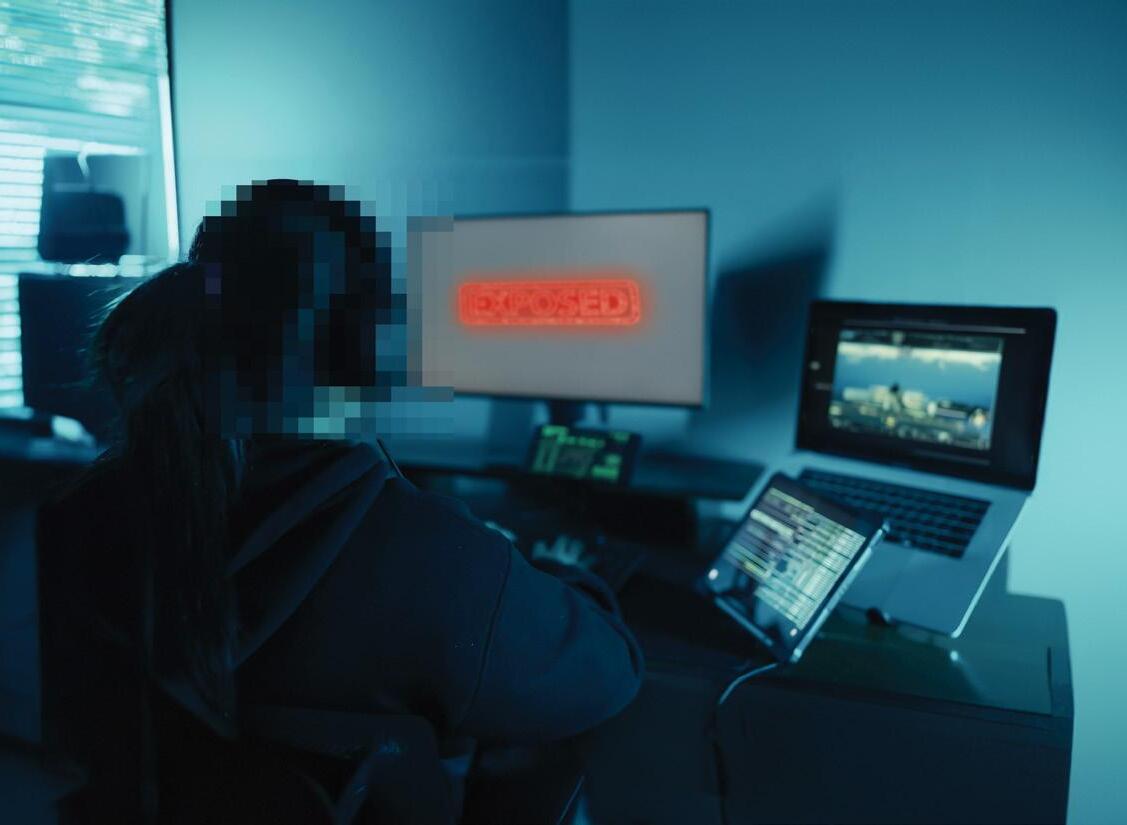
the abuse apart from session logs and data usage. As a result, police rely on money transfers, and call histories for evidence during investigation (ECPAT International, 2018). While the barriers to detection of CSA live-streaming offenses may be substantial when compared with the creation and sharing of CSAM material, it is possible that the difficulties detecting these offenses are similar to those of contact child sex offenses, including barriers to reporting by victims.
While this crime occurs in multiple countries (Europol, 2019), the Philippines has been identified as the “hub” from which CSA live streaming emanates (AUSTRAC, 2019; ECPAT International, 2018; EFC, 2015; Europol, 2019; Puffer et al. 2014). There appear to be several drivers of CSA live streaming emerging from the Philippines, including poverty, English language proficiency, wellestablished remittance services, and strong internet coverage (Batha, 2016; ECPAT International, 2018; Puffer et al., 2014). The high global demand for
CSA live streaming (Terre des Hommes, 2014), coupled with the poverty experienced in vulnerable countries appears to be a key driver for this crime type. The exploitation of vulnerable populations, and considerable power imbalance between offenders and victims contributes to the sinister nature of this crime type. While the present research considers offenses emerging from facilitators of CSA live streaming in the Philippines, it bears note that there are a range of countries that meet the similar characteristics of those suggested as supporting this crime type. Although current research identifies the Philippines as a hub for these offenses, as further research emerges, it is possible that other locations, and cohorts may be identified relating to CSA live streaming.
The financial element makes CSA live streaming different from, for example, CSAM offenses, where images and videos are mostly shared freely on the internet or traded for other CSAM (Europol, 2019). It also differs from online sexual solicitation of children, where money is
rarely exchanged. An analysis of chat logs from 179 offenders who solicited children online (DeHart et al., 2017) classified only a small sub-group as “buyers” of sex with children (13%, n = 23). Given that CSA live streaming is usually accompanied by a financial transaction (Europol, 2019), analysing these transactions is a key method for both detecting and understanding the offending behavior. Current research into online child sexual offenders has focused on CSAM and online solicitation offenders. Offenders who engage with CSAM and solicit children online have been categorised as younger, with limited employment and, consequently, limited access to finance compared with the general population (Babchishin et al., 2011). Babchishin et al. (2015) conducted a meta-analysis of 30 studies produced between 2003 and 2013 from the US, Canada, and the UK, finding that offenders that only accessed CSAM differed significantly from contact sexual offenders on a range of characteristics.
continued on page 22

Contact offenders were more likely to have access to children, score higher on antisocial personality measures, and more frequently commit minor offenses, than CSAM-only offenders. Additionally, Dowling et al. (2021) found that only a small proportion of CSAM-only offenders subsequently commit a contact child sexual offense.
Exploitation of children online appears to have increased over time, a trend that may have been aggravated by factors that emerged during the COVID-19 pandemic. While the drivers are unclear, there was a reportedly concurrent disruption to professionals that work to limit CSA live streaming (Salter & Wong, 2021). Additionally, reduction in victim support, and prevention initiatives resulting from pandemic disruptions, coincided with increased online and technologically enabled CSA activity (Salter & Wong, 2021). Given the current paucity of literature relating to CSA live-streaming offenders, we cannot be certain of the likelihood that these offenders, or aproportion of these offenders, may engage in contact sexual offending. It is pivotal to our understanding of these offenses, and the individuals that commit them, that some insight be gained into the relationship between CSA live streaming and contact sexual offending.
Previous research in adjacent fields considering contact sexual offending has adopted a range of approaches to explaining this phenomenon, including the motivation–facilitation model of sexual offending. This model suggests that paraphilia, high sex drive, and intense mating effort are each important motivations for online and offline sexual offenses (Seto, 2019). Alternate approaches include situational crime prevention, in which environmental or “situational” factors (e.g., access to children or CSAM) play a crucial role in an individual’s decision to sexually offend (Smallbone & Cale, 2016; Wortley & Smallbone, 2006).
Considering CSAM, and online solicitation offenders, qualitative analyses focusing on offending motivations, methodology, and use of language online, have suggested typologies, or sub-groupings of offenders (DeHart et al., 2017; Krone, 2004; Merdian et al., 2016;
Powell et al., 2021). Based on an analysis of language use in online chats, Powell et al. (2021) identified three distinct “clusters” of online solicitation offenders based on the language they used with child victims. These clusters were identified as impetuous, opportunistic, and devious offenders, referring to those seeking immediate gratification, those who were content to wait for an opportunity to arise, and those that were comfortable being patient but were more likely to display aggression in solicitation efforts (Powell et al., 2021). Similarly, in other research, CSAM offenders that accrued more prior offenses, were identified as more likely to re-offend through either online CSAM, or contact sexual offenses (Seto & Eke, 2015).
The paucity of literature specifically considering CSA live streaming has resulted in limited understanding of offenders, or offending. Given the success of prior research in classifying small samples of online sex offenders into typologies, and sub-groups (DeHart et al., 2017; Krone, 2004; Merdian et al., 2016; Powell et al., 2021), the present research considered whether there are also distinct subgroups of CSA live-streaming offenders. In particular, we consider whether certain subgroups are more likely to engage in contact sexual offending than others. This approach was driven by the scarcity of research into the characteristics of CSA live-streaming offenders, and the role that an understanding of this offender population, and its subgroups, may play in investigation, disruption, and prevention.
While the body of research considering technologically enabled CSA is emerging, comparatively little is known about the characteristics of offenders. The intention of this research is to consider the characteristics of CSA live-streaming offenders; we therefore pose three research questions:
1. To what extent are the CSA livestreaming offenders, among this sample, a behaviorally homogenous group? In particular, do they onset of offending around the same age, and feature similar criminal histories?
2. If there are identifiable sub-groups within these data, what are the key differences between groups?
3. Are some subgroups more likely to engage in contact child sexual offending?
To consider these questions, data were linked from two sources. The Australian Transaction Reports and Analysis Centre (AUSTRAC) collects and stores financial transaction data with the intention of detecting financial crime by individuals and businesses in Australia. Transaction data recorded by AUSTRAC may include amounts and dates, receiver details (including country), payment type, payment provider details, demographic data of the payer, and risk-related information on suspicious transactions. The Australian Criminal Intelligence Commission (ACIC) collects and stores comprehensive criminal history information on individuals in Australia via the National Police Reference System (NPRS). Information stored in the NPRS features charges and convictions for criminal offenses occurring in any jurisdiction in Australia, including the dates of offending, and demographic data on suspects and offenders (ACIC, 2019). In 2018, the Philippine National Police and the Philippine National Bureau of Investigation provided the Australian Federal Police with a list of 118 individuals arrested in the Philippines for facilitating the sexual exploitation of children (facilitators). The AFP provided the identities of these facilitators to AUSTRAC, who, using their financial transaction data holdings, identified 299 Australia-based individuals that had sent funds to these 118 known facilitators of child sexual exploitation in the Philippines. Transactions data from AUSTRAC, and criminal history data from the ACIC were linked using demographic data, and a unique individual identifier. Low confidence matches,in which we could not be certain that the criminal history referred to the individual making the transactions, were excluded, resulting in a dataset of 256 de-identified individuals. Data were then aggregated into a unit-record dataset, with data for each available variable referring to a unique individual that had processed transactions with facilitators between January 2006 and February 2019. Where demographic characteristics of individuals were unavailable, they were excluded from analysis. A final dataset of

Individual and live-streaming characteristics
Age at first live-streaming transaction 52.18 (20–76)
Age at first criminal offense (non-live streaming) 40.14 (n = 111) (18–76)
Mean number of criminal offenses 3.24 (1–51)
Mean harm produced per prior offense 90.23 (1–2370)
Mean total harm produced by prior offenses 343.77 (1–7315)
Mean number of live-streaming transactions 12.23(1–141)
Proportion of individuals that made 21 or more live-streaming transactions 0.096
Median days between live-streaming transactions 26.5 (0–746)
Median value spent per live-streaming transaction 65.41 AUD (11–1306)
Offending characteristics Exceed speed limit
Table 1. Demographic and Transaction Characteristics of the Sample of CSA Live-Streaming Offenders. Note. CSA = child sexual abuse; AUD = Australian dollars.
209 individuals that engaged in at least one transaction with known facilitators of CSA live streaming was available for analysis, featuring demographics, transaction characteristics, and criminal history. Given the sensitive nature of this research, the process of gathering and management of these data was developed in close consultation, with a Human Research Ethics Committee, with the
cleaning and analysis of the data approved and overseen by the same committee.
Several additional variables were generated for analysis. A prolific livestreaming variable was produced, as suggested by Cubitt et al. (2021). It was unusual for CSA livestreaming offenders to transact more than 20 times. A binary variable was therefore
developed to identify whether an individual transacted in high volume (21 or more transactions) with a facilitator. In addition to prior offense type variables, a variable was produced representing the harm resulting from prior offenses. Crime harm is emerging as a valuable measure of offending that
continued on page 24

accounts for the impact of offenses rather than the volume (Ashby, 2017). Specific to the Australian context, the Western Australian Crime Harm Index (WACHI) assigns a harm index weighted by court penalties (House & Neyroud, 2018). Prior research in Australia has operationalised this harm index to measure the extent of harm among criminal groups (Cubitt & Morgan, 2022; Morgan et al., 2020). Here, the WACHI was applied to the criminal history of each individual in these data, prior to their first live-streaming transaction, to provide two measures, the total harm produced by prior offenses for each individual, and the mean harm produced per prior offense. The full set of variables included in this analysis are described in Table 1 of the results.
While we can be certain that each transaction was to a facilitator of CSA live streaming, we cannot be sure that every transaction was for CSA live streaming. For example, it is possible that some transactions were for contact sexual offending against children (if offenders traveled to the Philippines) or for live adult webcam shows not involving children. However, in consultation with law enforcement subject-matter experts, it appeared unlikely the transactions were for contact sexual offending given such purchases are usually made with cash in the destination country (Brown et al., 2020). Therefore, it is unlikely that these Australia-based individuals were sending money to facilitators for reasons other than child exploitation, and at the very least we can be confident that the vast majority of transactions
considered here reflect CSA livestreaming transactions. The transactions analysed here relate to the outcomes from a large law-enforcement operation in the Philippines that identified a cohort of Australians sending money to known CSA live-streaming facilitators. The extent to which this group is representative of all individuals who purchase CSA livestreaming sessions, or whether they are specific to the facilitators considered here, is unclear.
K-Means
K-means is a centroid-based clustering algorithm (Bora & Gupta, 2014), that is particularly useful in uncovering latent groups in complex data (Brennan & Oliver, 2013). K-means has been used to uncover latent behavioral groupings, and typologies, among a range of intimate partner violence, and interpersonal violence domains (Boudoukha, 2013; McKinney et al., 2016; Serie et al., 2017; Thijssen & de Ruiter, 2010). Importantly, k-means has demonstrated efficacy in identifying characteristic, and behavioral subgroups among perpetrators of crime that may be used in clustering and better understanding individuals that commit those offenses (Mach et al., 2017). The intention of this research was to consider whether there were previously unknown subgroups within the larger group of CSA live-streaming offenders, a task for which k-means has demonstrated utility.
Given the number, and ensemble of sub-groups within these data were unknown, we implemented a cascading process for identifying clusters of CSA
live-streaming offenders. First, the Hopkins statistic was implemented; this metric was employed to identify whether these data were or were not clusterable (Banerjee & Dave, 2004). The optimal number of clusters (k) must then be identified prior to implementation of the k-means algorithm. To do this, we employed the elbow method (Maheswari, 2019) to identify how many latent clusters were present in these data; we then confirmed this number using the gap statistic (Maheswari, 2019; Tibshirani et al., 2001). With the optimal number of clusters identified, we then employed k-means for analysis (Amer, 2020; Jain & Dubes, 1988).
To provide a visual representation of k-means clusters, we separately computed a Principal Component (PC) Analysis (PCA). PCA is used to condense several variables into, in this instance, two vectors, that best describe the extent to which individuals are similar or different. In the PCA cluster plot provided here, the first and second PCs are selected, and plotted on the x and y axes, titled Dim1 and Dim2 respectively. In brackets, on each axis, the proportion of variance accounted for by each PC is provided.
Metrics used to evaluate k-means. To assess the performance of k-means, the Silhouette coefficient was used. The silhouette coefficient measures how well clusters are separated, with the mean silhouette coefficient identifying the reliability of the clusters produced by k-means (Batool &Hennig, 2021). A silhouette coefficient is between −1 and 1 (Lleti et al., 2004). A negative score indicates that there is low confidence
in the clustering of the associated data, while a positive score indicates that we can be confident in the accuracy of data attributed to that cluster.
The characteristics of each cluster of CSA live-streaming offenders were then compared, with a focus on considering the nature of, and any differences between, these latent groups. Analysis was performed using statistical analysis software, R, and the “dplyr,” “cluster,” “geosphere,” and “factoextra” packages.
Results
The Hopkins statistic was computed to test the tendency of these data to cluster; if the Hopkins statistic for these data was greater than 0.5, clustering would be considered a poor analytical methodology. Here, the Hopkins statistic returned 0.027, meaning there was high confidence that these data were clusterable, and k-means appears to be an appropriate methodology for analysis.
CSA live-streaming offenders appeared to exhibit onset of other criminal behaviours at a younger age than live streaming. Table 1 suggests, that among those that featured a criminal history, offending began prior to onset of transactions to facilitators of live streaming. The mean number of offenses by this group was relatively low, with most common offenses being relatively minor, including speeding, theft, and public order offenses, reflected in the low mean harm produced by offenses. However, after onset of live streaming, these offenders appeared to be persistent, with a mean of 12.23 transactions to live-streaming facilitators. These transactions were at

“CSA live-streaming offenders appeared to exhibit onset of other criminal behaviours at a younger age than live streaming.”
brief intervals, with a median of less than a month between transactions, and for relatively low financial value, with a median of 65.41 Australian dollars per transaction.
Latent Cluster Quality and Content
Figure 1 suggested that clustering these data into three distinct groups was most appropriate, with a strong mean silhouette width of 0.79 for three clusters.
Notably, the difference between two and three clusters was only a marginal improvement in cluster accuracy. The gap statistic presented in Figure 2 confirmed that three clusters was optimal, however, it also confirmed that the difference between two and three clusters was marginal. As noted later in these results, the third cluster featured only a small number of individuals.
Silhouette coefficients for each individual cluster were computed, and provided visually as Figure 3. The first, and largest cluster consisted of n = 178 CSA live-
streaming offenders (Silhouette coefficient = 0.92). Cluster 2 comprised of n = 28 (Silhouette coefficient = 0.48) again featuring strong confidence in the clustering. Finally, Cluster 3 was a difficult group to cluster (Silhouette coefficient = 0.20), and only featured three individuals (n = 3).
The small number of individuals in Cluster 3 appeared to feature similar characteristics to Cluster 1. The primary difference, and reason that these individuals were separated out into a different cluster was the value of financial transactions to facilitators. Individuals in Cluster 3 processed substantially higher value transactions per CSA livestreaming session, than those in either of the remaining clusters. However, outside of transactions, their characteristics were notably similar to individuals in Cluster 1, reflected by the PCA locating this small cluster as within the bounds of Cluster 1 (Figure 4).

(20–76)
(37–74) Age at first criminal offense (non-live streaming)
(n = 83) (18–76)
Mean number of criminal offenses 2 (1–25)
Mean harm produced per prior offense
Mean total harm produced by prior offenses
Mean number of live- streaming transactions
Proportion of individuals that made 21 or more livestreaming transactions
Median days between live- streaming transactions
Median value spent per live- streaming transaction
Note. CSA
The third cluster consisted of only three individuals, the primary difference being the median transaction value of these individuals was 2,733.4 Australian dollars (AUD). While this transaction value made them identifiable as a separate cluster, they were in no other way discernable from Cluster 1. As a result, these three individuals were separated from the remaining analysis, which focuses on the two primary clusters.
Table 2 provides demographic and transaction characteristics for clusters identified by k-means, Table 3 provides the mean number of offenses committed per individual in each cluster. Cluster 2 was a notable sub-group, featuring 13.4% of the sample. The age of onset of live streaming was similar; however, the onset of non-live streaming offending in Cluster 2 was earlier; these individuals also featured a larger number of criminal offenses on average. While Cluster 2 were more prolific in other crime types, on average they engaged in fewer live-streaming transactions. Despite this, the proportion of high-volume live streamers (21 transactions or greater) was similar in each group. While Cluster 2, on average, engaged in fewer live-streaming transactions, the timeintervals between these transactions were notably shorter than those of Cluster 1.
Table 3 focuses on the comparative offense rates, prior to the first instance of CSA live streaming. Individuals in Cluster 2 were notably more prolific across all crime types, however particularly
(0.05–545)
(1–1110)
(1–479)
(0–746)
AUD (11–1306)
those that produced substantial harm, such as assault, break and enter, public order, theft, and drug offenses. Despite comprising the majority of these data, individuals in Cluster 1 did not feature in any recorded contact sexual offenses against either adults or children. Comparatively, individuals in Cluster 2, featured in notable rates of contact offending against both adults and children.
These findings suggested that there were two demonstrably different groups among these CSA livestreaming offenders. Cluster 1 made a larger number of transactions, and appeared to spend a higher median value per transaction; when they did offend outside of CSA live streaming, this group exclusively did not feature in recorded contact sexual offenses. Cluster 2, however, featured in a notable rate of contact sexual offenses, and were also responsible for a comparably high rate of nonsexual violent offenses. These findings suggest that, while the majority of CSA live-streaming offenders in this sample specialised in online victimisation of children, there was an important sub-group, comprising 13.4% of the sample, that engaged in other crimetypes, importantly a relatively high rate of contact sexual offending against both adults and children.
Discussion
Due to the noted difficulty detecting CSA live-streaming offenses, our understanding of these offenders, and their offense methodologies, is only emerging. As a result, there is little
(n = 28) (18–62)
(1–51)
(55.28–2370)
(1449–7315)
(1–141)
(0–150)
AUD (17–191)
comparison available in the literature for the characteristics of offenders that engage in CSA live streaming. This research represents the first empirical evidence suggesting an intersection between CSA live-streaming offenders, and contact sexual offenders. However, it appears that, among this group, the majority of CSA live-streaming offenders specialised in online offending, and did not appear to commit other times of criminal offenses, contributing to the noted detection difficulties for this offender group.
In considering the neighboring field of CSAM engagement, Knack et al. (2020) suggested elements of habituation and compulsion. The time periods between offenses suggested that an element of compulsion may feature among the present sample; however, there was a notable difference between the two primary clusters. Cluster 1, featuring specialist CSA live-streaming offenders, transacted with facilitators roughly once per month, while individuals in Cluster 2, a group of more generalist offenders, transacted more than twice as frequently. The former group were more likely to be persistent, with a higher overall number of transactions than the latter group. Although it is likely that, by virtue of being more prolific violent and contact sexual offenders, the latter group may be detected before the specialist CSA livestreaming group. The brief time periods between livestreaming sessions among Cluster 2, and persistent nature of these offenses, suggests this sample may have features of compulsive behaviors as described by Knack et al. (2020).

Table 3. Number of Offenses per Individual in Latent CSA Live-Streaming Clusters. Note. CSA = child sexual abuse; AUD = Australian dollars.
The majority of CSA livestreaming offenders in this sample had little to no history of criminal offending, and had no recorded contact sexual offenses against either adults or children. The offense types that were most often committed by these individuals produced limited harm, suggesting that they were largely a homogenous offending group, that almost exclusively engaged in the online sexual abuse of children. However, findings suggested that there was a notable sub-group within this sample of CSA live-streaming offenders, featuring offline offending behaviors that differentiated them from the rest of the sample. Compared to Cluster 1, Cluster 2 were more prolific among every offense type, and onset of offending behaviors notably earlier. Pivotally, this sub group committed a significant rate of contact sexual offenses alongside CSA live streaming.
Among CSAM offenders, research suggests that the rate of recorded sexual offenses may be substantially lower than the rate of self-reported contact offending (Seto, Hanson and Babchishin, 2011). While the sample here is marginally different to CSAM offenders, it is possible that the actual rate of offending, particularly sexual offending, is higher than the rate that is detected, and recorded. However, based on recorded criminal offenses available to this analysis, Cluster 1 and Cluster 2 appear to be two distinct groups of offenders. The identification of a specialist CSA live-streaming cluster, and a separate cluster that committed violent and contact sexual offenses, aligns with previous research into CSAM offending. Henshaw et al. (2018) found that mixed offenders who commit both CSAM offenses and contact sexual offenses feature a higher degree of antisociality, while Babchishin, Hanson and VanZuylen (2015) note that they also tend to engage in a higher rate of violent offenses than CSAM-only offenders. Although it may be a relatively
intuitive finding, research in this field has, to date, lacked empirical evidence that CSA live-streaming offenders may also engage in contact sexual offending. While we rely on recorded offenses for this analysis, it appears that there is an intersection between CSA live-streaming offenders, and violent and contact sexual offenders.
Monitoring of financial transactions is a central aspect of detecting these offenses. In Australia, AUSTRAC monitors certain classes of transactions, for example, any international fund transfers regardless of the value are subject to monitoring and reporting requirements (Anti-Money Laundering and Counter Terrorism Financing Act 2006 (Cth)). However, these reporting requirements are unique to Australia. In 2006, the United States Department of Treasury produced a discussion paper on the feasibility of a cross-border electronic
continued on page 29
































funds transfer reporting system (U.S. Department of Treasury, 2006), concluding that a federal monitoring framework may improve detection of crimes involving international financial transfers. However, to date, there remains no central monitoring of international funds transfers in the United States. The United Kingdom are subject to similar reporting limitations. In 2021, G20 countries agreed to improve the ease of cross-border financial transactions; however the implementation of centralised monitoring approaches was delayed (Financial Stability Board, 2021), leaving UK regulatory agencies with limited visibility of international funds transfers. It is an important implication for detection of these offenses that monitoring frameworks such as those that facilitated this research do not exist in the United States, or United Kingdom. While it would significantly benefit detection methodologies if these frameworks were implemented, until such regulations are imposed, opportunities for improving detection of this crime type principally relate to multi-agency partnerships. Financial institutions (banks, credit-card companies, and money service businesses) hold and consistently analyse data on financial transactions (FFIEC, 2020); these likely include transactions made by CSA livestreaming offenders. In the United States, the Fedwire, and the Clearing House Interbank Payment System (CHIPS) are the two primary payment systems for money transfer (FFIEC, 2021). The information held by these services presents an opportunity for partnership with law enforcement, that may help in the detection of CSA livestreaming offenses (Batha 2016; ECPAT International 2018; Puffer et al. 2014).
The volume of cross-border transactions suggests that manual detection of CSA live-streaming transfers is impractical; for this reason machine learning techniques are increasingly applied to financial transactions data for the identification of potential criminal offenses. For example, fraud (OECD, 2021; Nandi et al, 2022), tax avoidance (Korsell, 2015), money laundering, and terrorism financing (Canhoto, 2020) are common applications. However, to detect these offense types, the characteristics of transactions, and offenders, must first be known. Findings in the present
It is an important implication for detection of these offenses that monitoring frameworks such as those that facilitated this research do not exist in the United States, or United Kingdom.
study demonstrate that where data are available, machine learning analytics may discern coherent groupings of CSA live-streaming offenders. These types of modeling offer an opportunity for identification of transactions among linked data from financial services, and law enforcement, that adhere to the characteristics of CSA livestreaming transactions. For example, considering financial data, transaction intervals, transaction value, and transfer locations offer opportunity for refining risk indicators. When linked with offending data, recorded criminal history may considerably refine risk indicators. Not only is flagging suspicious transactions that appear similar to CSA live-streaming transactions a reasonable prospect, given the noted differences in financial and offending characteristics between the clusters identified, it appears that stratifying suspicious transfers by risk may also be feasible.
These findings suggest that typologies developed among smaller samples of CSAM offenders may have similarities to CSA live-streaming offenders, at least to the extent that they both feature a subgroup more likely to engage in contact sexual offending (Krone, 2004; Merdian et al., 2016). However, when considered in conjunction with the frequency of transactions among Cluster 2, there may be an element of compulsion, and persistence among these offenders not previously identified. This notion, described by Knack et al. (2020) centers on the frequency of CSA live streaming, and in particular, the intersection of compulsive behavior and the likelihood of engaging in contact sex offenses in addition to CSA live streaming. While further research is required to confirm this effect, there are potentially significant implications
for management and judicial decision making, relating to these offenders.
The present research is the first to empirically identify an intersection between CSA live-streaming offenders, and contact sex offenders. While this is a niche group of offenders, as the research base grows, it appears that this crime type is increasingly prevalent (Salter & Wong, 2021). Findings from the present research hold important implications for the monitoring of international financial transactions, multi-agency collaboration, and the implementation of machine learning analytics in support of detection of these offenses.
This research was limited in its ability to consider the diversity of the population studied, as there was no demographic information regarding cultural background, and these offenders were exclusively male. However, we were able to focus on the diversity of offending in relation to age. There are a few crime types that have an onset as late in age as that for live streaming of CSA; however, the findings here suggested that regardless of cluster and offending frequency, onset of CSA live streaming most commonly occurred after the age of 50. While this is a limitation of the offender sample, we focus on the underrepresentation of victims of this offense type among literature. This research employed data in which victims were exclusively children in the Philippines. The live streaming of CSA is facilitated by factors including poverty, well-established remittance services, and strong internet coverage (Batha, 2016; ECPAT International, 2018; Puffer et al. 2014), and have the greatest impact on a population with little ability to report, or prosecute offenders. The substantial
continued on page 31



power imbalance between offender and victims of these offenses serves to underscore the importance of research into offense methodologies, offenders, and possible disruption approaches, to limit the ability of offenders to exploit this vulnerable population.
While the limitations relating to these data are set out previously, it is notable that we cannot be certain whether the 118 facilitators from which these data emerge, are comprehensive. It is likely that this is a sub-sample of active CSA live-streaming facilitators and ultimately, while this research establishes valuable steps in understanding these offenders, findings should be considered as relating to Australia-based offenders, and relating to the group of detected facilitators. It is possible that, as further data emerges from different locations or offender cohorts, research may find greater variation in the characteristics of these offenders and their offense methodologies. Further, while we use the metric of transactions to indicate livestreaming events, it is possible that each transaction does not relate to a single live-streaming event.
Given the differing financial value of these transactions, it is possible that individuals in these data were processing payments in fragments to avoid detection. Alternatively, larger financial transactions may have been intended to procure more than one CSA live-streaming event.
Given the paucity of research in this field, we have chosen to situate these findings among the literature considering online child sex offending, including the production and sharing of CSAM, and
online solicitation of children. However, as research continues to become available, it may be important to compare the characteristics of CSA live-streaming offenders to those of sex trafficking offenders, and sex tourism offenders. Although access to data on offenders in these fields is also limited, it is possible that the characteristics of these offenders may bear similarity to CSA live - streaming offenders.
K-means implicitly assumes that all clusters have the same radius; when this assumption is violated, the resulting clusters may behave in an unusual way (see Raykov et al., 2016 for examples).
To ensure this analysis did not violate the clustering assumptions of k-means, we produced the PCA plot alongside cluster findings. While there were some outliers, these were reasonable outliers when compared with the data. Additionally, k-means assumes that the number of clusters in the data is known prior to analysis (Raykov et al., 2016). Given this research sought to identify latent sub groups through clustering, this was not the case here. To address this limitation, the number of clusters was determined by using the elbow method, and validated using the gap statistic, to minimise withincluster outliers. As a result, the clusters produced here were robust, with the silhouette coefficient suggesting high confidence in the clustering decisions of k-means. However, it bears note that future research employing a supervised learning methodology may improve understanding of model accuracy, if the dataset supports this approach.
the Newcastle Local Area Command - our partners in making Newcastle a safe and liveable city for all members of our community.
Live streaming of child sexual abuse is a technologically, and financially enabled crime type, that is difficult to both detect and disrupt. While evidence is emerging regarding offending methodologies, it is pivotal to better understand the characteristics of these offenders. This research suggests that CSA livestreaming offenders may predominately be specialists; however, there was a notable sub-group that also engaged in contact offending against both adults and children. These appear to be prolific and persistent live-streaming offenders, and while their criminal histories may vary, they tended to onset of live-streaming offending around the same age, before making regular transactions with facilitators at brief intervals. These offenses attract limited attention due to their transnational nature, minimal visibility, and there being little forensic evidence of each occurrence. Despite this, it is an insidious and exploitative crime type, that produces significant trauma among victims. This research offers insight into the offending behavior, and criminal histories of those that engage in CSA live-streaming offenses. This is an area requiring a greater research focus, including increased empirical analysis of offender characteristics and offense methodologies to inform disruption strategies.




• Brow Lift
• Meloplasty (Facelift)
• Upper Blepharoplasty (Upper Eyelid Lift)
Individual surgery decisions are made during a personalised consultation with Dr Lim where patient safety, education and optimal results are our top priorities.


BREAST
• Breast Augmentation (Breast Implants)
• Reduction Mammoplasty (Breast Reduction)
• Augmentation Mastopexy (Breast Lift with Implants)
• Mast opexy (Breast Lift)
BODY
• Lower Circumferential Lipectomy (Lower Body Lift)
• Upper Circumferential Lipectomy (Upper Body Lift)
• Brachioplasty (Upper Arm Lift)
• Medial Thigh Lipectomy (Medial Thigh Lift)
• Abdominoplasty (Tummy Tuck)
• Liposuction

Warning: this paper contains graphic descriptions of child sexual abuse.
Australian Institute of Criminology

Abstract
We analysed the chat logs of seven Australia-based men who had committed 145 child sexual abuse (CSA) live streaming offences, to examine the overlap between this offending, contact sexual offending and engagement with child sexual abuse material (CSAM).
Four CSA live streaming offenders attempted to travel to offend against victims in person, in that they discussed travelling or actually booked flights in order to meet these children. Offenders also requested or received images and videos of victims they had viewed over live stream, and recorded live streams to produce CSAM.
Travelling to offend against children, use of CSAM and CSA live streaming appear to be interrelated and should be considered by law enforcement as potential risk factors for one another.
Further, detection and removal of new CSAM, and scanning of live streams for abusive content, should be a priority for all electronic service providers.
Background
Child sexual abuse material (CSAM) refers to images and videos that depict the sexual abuse of a child. Popular video call platforms such as Facebook Messenger and Skype have been used by Australian men to view the live streamed sexual abuse of children in vulnerable countries (Napier, Teunissen & Boxall 2021a). Child sexual abuse (CSA) live streaming differs from CSAM offending and contact sexual abuse in that the offender
is in a different location to the victim and requests specific acts to be performed by the child or perpetrated against the child by another individual facilitating the abuse (WeProtect Global Alliance (WPGA) 2021).
Law enforcement and non-government organisations have indicated that CSA live streaming is increasing (Interpol 2020; Netclean 2019; WPGA 2021) and is often facilitated by third-party traffickers (WPGA 2021). Offenders will often pay small sums of money (usually under A$100, and as low as A$13) to either the victim or facilitator for CSA live streaming (Brown, Napier & Smith 2020; Cubitt, Napier & Brown 2021; Napier, Teunissen & Boxall 2021a, 2021b). While these facilitators can be part of organised criminal groups, research has found that they are commonly adult female relatives of the victims, acting alone and seeking money for basic living necessities (International Justice Mission 2020a; Napier, Teunissen & Boxall 2021b). While many countries are at high risk of CSA live streaming (Netclean 2019), South East Asia, in particular the Philippines, has emerged as an epicentre for this type of exploitation, particularly when being sourced by Australian offenders (AUSTRAC 2022).
face-to-face, which was exemplified during the COVID-19 pandemic (Europol 2021; Interpol 2020). However, at the time of writing, only one empirical study could be located that examines the overlap between CSA live streaming and contact sexual offending (Cubitt, Napier & Brown 2022). Further, little information was available on how CSA live streaming interacts with CSAM offending.
CSA live streaming and contact sexual offending Research, including meta-analyses and rapid evidence assessments, has found that a small minority of detected online sexual offenders will subsequently be detected for a contact sexual offence (1%–8%; Dowling et al. 2021; Seto & Eke 2015; Seto, Hanson & Babchishin 2011). However, this research did not focus on CSA live streaming offenders, and very little is known about whether individuals who view CSA live streaming also commit contact CSA offences in person. A study of 256 Australian CSA live streaming offenders found that only seven percent had a prior sexual offence against a child in their criminal history (Brown, Napier & Smith 2020). Further analysis identified a subgroup of CSA live streaming offenders who engaged in contact sexual offending and had characteristics unique to those who did not (Cubitt, Napier & Brown 2022). Important to note, however, is that criminal justice figures likely under-represent actual CSA offending. For example, Schuler et
According to law enforcement agencies internationally, offenders are also recording live streams to ‘sextort’ victims and to create and disseminate CSAM online (Australian Federal Police (AFP) 2021; Europol 2020). Europol and Interpol suggest that offenders use online child abuse and exploitation as an alternative to contact sexual offending when they are unable to meet victims continued on page 35

Remembrance Day is an occasion to honour those officers who have lost their lives while performing their duties. It is an important reminder of the continued dangers that our brave men and women in blue face each day in serving the community.

State Member for Wallsend Deputy Speaker



Victim
Chat log
Child sexual abuse material (CSAM)
CSA live streaming offence
Travel to offend
Facilitator (also known as a trafficker)
Offender
al. (2021) surveyed 4,161 respondents who accessed a web-based intervention app for individuals with a sexual interest in children and completed a ‘self-assessment’. They found that 41.5 percent self-reported ever committing CSA, while only 9.4 percent had been prosecuted or sentenced. Further, given that CSA live streaming offenders target victims located in vulnerable countries for online abuse (Napier, Teunissen & Boxall 2021b), they may also target victims in vulnerable countries for contact CSA offending to avoid being detected. However, little research is available to verify this.
Travelling abroad to sexually abuse children is an ongoing problem, particularly in countries where children are vulnerable due to poverty, corruption, and limited community knowledge of offending (AUSTRAC 2022). A survey of 8,718 German men in the community found that 1.5 percent (n=132) admitted to sexually abusing a child in the past (Koops et al. 2017). Within this group, over a quarter (27%, n=36) reported travelling to a foreign country to pay a child for contact CSA. Intelligence-based information from law enforcement agencies suggests that individuals who view CSA live streaming may subsequently travel to sexually abuse the child/children they viewed virtually in person, or other children (AUSTRAC 2022).
International Justice Mission (2020a) released a report on the characteristics of online CSA offenders based on 44 case referrals of online sexual exploitation of children and young people (including CSA live streaming) where
Child or young person (below the age of 18) who was abused or referenced/ involved in negotiations for CSA live streaming. This would occur either as a result of the victim conversing directly with the offender or being ‘offered’ to the offender by a facilitator.
Online discussions between an offender and a facilitator and/or victim.
Photos or videos of children (under 18) being sexually abused/exploited.
An attempt by an offender, either successful or unsuccessful, to watch a child being sexually abused via a live stream video platform.
An expressed desire or intent either to travel to another location to sexually abuse a child, or to arrange for the victim to travel to the offender’s location for sexual abuse.
A person who organises and coordinates the abuse of a child over live stream, and often collects the money from the offender.
An individual who attempts to view CSA live streaming.
offender information was available. They found that Australia was the third most common nationality (18%) among these offenders, and that 39 percent of cases involved online sexual exploitation ‘customers’ (offenders) who were known to have travelled to the Philippines at some point in their lives. This suggests that some offenders who engage in CSA live streaming or other forms of online sexual exploitation of victims in vulnerable countries may be prone to visiting these countries.
Very little is known about the role played by the viewing or sharing of CSAM in CSA live streaming offending. For example, individuals who view children being abused live online may also view abusive images and videos of children online, yet little information is available on whether this is the case or whether one behaviour precipitates or substitutes for the other. The Internet Watch Foundation (2018) analysed over 2,000 video captures from CSA live streaming sessions, which demonstrates that the live streams are sometimes recorded and distributed online. Insoll, Ovaska and VaaranenValkonen (2021) found that 45 percent of 5,171 CSAM offenders surveyed anonymously on the darknet said they had viewed CSA live streaming. Research is required to explore how CSA live streaming is intertwined with CSAM offending and contact CSA offending. It is important to gain insight into whether individuals who pay to watch children being abused live online are at risk of travelling to abuse children
in vulnerable countries, and whether they also consume CSAM in the form of images and videos. Knowing this will assist in identifying important intervention points and indicators for this offending, to disrupt escalation.
The current paper forms part of a series of studies (see Napier, Teunissen & Boxall 2021a, 2021b) examining the chat logs of Australian CSA live streaming offenders to better understand the nature of this crime type. This study investigated the links between CSA live streaming and other forms of CSA perpetrated by the offenders, including CSAM offending and contact sexual offending against children. The study aimed to answer three research questions:
§ Do CSA live streaming offenders attempt to travel to offend against children face-to-face in vulnerable countries and what are the circumstances surrounding these attempts?
§ Do offenders form relationships with victims and facilitators online and what part does this play in the offending?
§ What part does engagement with CSAM play in CSA live streaming offending?
Sample
This study was approved by the Australian Institute of Criminology (AIC) Human Research Ethics Committee in 2020 as part of a series of studies. The AFP provided the AIC with chat logs from cases of seven Australian men aged

42 to 72 years (median=58 years) who had been investigated for attempting to view, pay for and often direct CSA live streaming of children overseas (predominantly in the Philippines) between March 2012 and April 2019. This was a purposive sample and was limited to cases that the AFP was currently or had finished investigating (see Napier, Teunissen & Boxall 2021a for more detail).
Analysis and key measures
Grounded theory and protocols (Charmaz & Belgrave 2012; Glaser 1978) were implemented due to the exploratory nature of this study. The themes identified were primarily led by the data rather than a prescribed set of pre-existing coding frameworks. Key information was extracted from the chat logs—for example, when offenders discussed intentions to travel to offend against victims, or when they negotiated with facilitators/victims over obtaining CSAM. For each case, discussion between an offender and victim or offender and facilitator about travel was coded as not present (0) or present (1). For example, an offender explicitly discussing travel plans including sharing flight details with victims or facilitators was coded as travel to offend=1, and when an offender did not mention travelling to offend in any capacity, this was coded as travel to offend=0. Attempts to access CSAM (images or videos of victims) were also coded as not present (0) or present (1). Travel to offend attempts were defined as an expressed desire or intent either to travel to another location to sexually abuse a child, or to arrange for the victim to travel to the offender’s location for sexual abuse. This included:
§ the offender requesting of a victim or facilitator to meet a victim in person to have sexual contact with them, or agreeing to such a request, regardless of whether the meeting took place;
§ the facilitator or victim agreeing to arrange in-person contact between offender and victim for sexual contact, regardless of whether the meeting took place;
§ the offender booking travel (eg flights for himself or the victim) and/ or successfully travelling to meet the victim in person with an expressed intent to have sexual contact with them, regardless of whether the sexual contact took place.
Firstly, the data were qualitatively analysed in NVivo 10 (Lumivero nd) by reading the data line-by-line and applying basic codes. Secondly, these data were analysed in greater detail to identify additional subcategories and themes. Finally, additional analysis and coding were performed to identify relationships between existing codes and to link them with theory (Thornberg & Charmaz 2013; Urquhart 2012). The authors discussed findings and agreed on the coding framework at each stage of analysis. Quantitative information was stored and analysed in Microsoft Excel and Stata MP14.
It is important to note that, while some attempts to travel to offend were clear and involved offenders catching flights and arranging accommodation, others likely did not evolve past discussion. We could not determine from the data whether some discussions of travel were motivated by fantasy, such as has been highlighted in research into the online sexual solicitation of children (Broome, Izura & Lorenzo-Dus 2018). Nevertheless, all discussions in the chat logs about travelling to offend were relevant to the research questions as they illustrate offenders’ desires and thought processes relating to contact sexual offending and the willingness of facilitators and victims to grant in-person access to victims for sexual abuse.
It should be noted that the current study was based on a small sample of CSA live streaming offenders who may be at the severe end of the offending spectrum, which may be why they were detected by police. Therefore, observations about the number of CSA live streaming offenders who attempted to travel to offend against children in person or who engaged with CSAM cannot be applied to the general population of these offenders. Further, the sample was based on chat logs that were available to police. It is likely that many CSA live streaming offenders delete their chat logs to avoid detection, and the study could not capture those individuals. Despite these limitations, the study is valuable given the dearth of research into the characteristics of CSA live streaming offending and in particular its co-occurrence with other forms of child abuse and exploitation. Further, chat logs provide genuine insight into offending behaviour, given the individuals are not aware they are being observed, whereas survey research can
suffer from biases (McGrath, Cann & Konopasky 1998; Tan & Grace 2008).
Offenders paid to watch CSA live streaming involving 74 victims, predominantly in the Philippines; as outlined in Napier, Teunissen and Boxall (2021a), two offenders offended against the majority (n=44) of these victims. See Napier, Teunissen and Boxall (2021a, 2021b) for an in-depth overview of the characteristics of victims, offenders, facilitators and offences relating to the present sample, including how offenders accessed victims for CSA live streaming.
The study investigated whether CSA live streaming offenders attempted to travel to sexually offend against child victims in person. Four of the seven offenders attempted to travel to offend; one of these also attempted to arrange for a victim to travel to Australia. Available information indicates that these four offenders attempted to travel to offend against almost a third of their 62 victims (n=20, 32%). Travelling to offend against victims was discussed with five (29%) facilitators during online communications (Table 2). Table 2 displays the variation between offenders in attempts to travel to offend. For example, in Case 1, the offender offended against 22 victims over live stream, and discussed travelling to offend with seven of these victims as well as one facilitator. The offender in Case 2 also offended against 22 victims (where relevant information was available) and discussed travelling to offend with two of his victims but no facilitators. Conversely, the offender in Case 7 discussed travelling to offend with most of his CSA live streaming victims (10/14) and all four facilitators. The offender in Case 4 discussed travelling to offend with one of his four victims.
Of the four offenders who attempted to travel to offend, three (Cases 1, 2 & 7) made these attempts after viewing their victims in CSA live streaming sessions. In the fourth case, it was unclear whether attempts to travel to offend occurred before or after CSA live streaming. Table 3 displays an excerpt of the 18-month-long conversation between
continued on page 38

a: The offenders in Cases 3, 5 and 6 did not appear to discuss traveling to offend with any of their victims (n=12)
b: The four offenders who attempted to travel to offend committed CSA live streaming offences against a total of 62 victims, although did not discuss travelling to offend with most of them
c: The four offenders who attempted to travel to offend engaged with a total of 17 facilitators, although did not discuss travelling to offend with most of them
Source: AIC CSA Live streaming dataset [computer file]
Victim: …while ur not here yet we just use a cam to cam ok?
Offender: can I see you pls
Victim: no cam here
Offender: :’(…I miss your body I thought after you got money, I would see your sexy bits <3 Who i will sex with when I’m there You, [name] and [name] sister, but not your sister?
I am scared to meet you, I still dont know much about you, /i’d like to talk to your family I’m spending 106,000 peso to come and see you… show me how much you love me… you only going online to ask for money is heart breaking…you dont care enough about ME. :’( want to see more of you <3
Victim: Hi my love i love you i miss you so much
Offender: missing my love too, loving your little video’s so much too <3 The conversation continues and the offender shares his flight details and arrival time.
Note: Some messages between the victim and offender were removed for brevity. Message content is presented verbatim
Source: AIC CSA Live streaming dataset [computer file]

Offender: can i ask you something.
Facilitator: sure
Offender: is [10-year-old girl] your daughter
Facilitator: yes
Offender: thats good i like that we will be very close and the other girls [12-, 14- and 15-year-old girls]…they are your daughters too…???
Facilitator: no nieces
Offender: nice too. i like that as well we will come to a nice agreement with their parents......
Facilitator: yes if u will meet in real not have problem
Offender: yeahhh. thats right i pay them very well and i get there permission
Note: Some messages between the facilitator and offender were removed for brevity. Message content is presented verbatim
Source: AIC CSA Live streaming dataset [computer file]
an offender and victim. After viewing the victim in CSA live streaming sessions and in videos and images sent by the victim, the offender purchased flights to the Philippines and met the victim in person. However, it is not clear whether sexual abuse occurred, as the offender complained in a later message: ‘why are you always so hard on me for money, but not let me touch you when I was there, a good wife would be comfortable naked in the arms of her husband’. Please note that these chat logs are presented verbatim and are often graphic in nature. Similarly, after viewing children in a CSA live streaming session, the offender in Case 7 continued to communicate with the facilitator and discuss travelling to offend against the same children in person (Table 4). It is not clear whether this was fantasy-driven or if the offender travelled and abuse occurred, but the facilitator agreed to arrange for an in-person meeting with the children.
Forming relationships when arranging CSA live streaming
While all offenders had transactional relationships with facilitators and victims, it was evident from their communications that some offenders perceived that they were in an intimate relationship with these individuals. The perceived relationships were usually characterised by financial support for victims and facilitators and by offenders’ desire to have sexual contact with a child. As demonstrated earlier in Table 3, for example, both the offender
and the victim used romantic language towards one another.
In another example, the offender used sexualised language with a 20-year-old female facilitator during communications (‘when im there baby… we will have a very good time… I will take you shopping… your pussy will be mine… soon as im there I will look after you and the girls… and we will have fun together’; Case 7). Even when younger, pre-pubescent children were offered by facilitators or requested by offenders for CSA live streaming, the offenders would sometimes request to talk to these children over chat before or during the CSA live stream session.
Engagement with CSAM
Information from police briefs indicated that three of the offenders were found in possession of CSAM on their devices (Table 5). This information was not available for the remaining four cases. For offenders in Cases 1 and 3, this included large numbers of CSAM files (312 and 1,072 respectively) created during webcam sessions. This suggests that some CSA live streaming offenders generate their own CSAM through live streaming sessions.
It was common for offenders in the sample to request images and/or videos of the victims they viewed in the CSA live streaming sessions. Six of the seven offenders either requested or were offered (by facilitators or victims) images or videos of at least one of their victims.
When examining this figure with the victims as the unit of analysis, of the 74 CSA live streaming victims in the study, 48 (65%) received requests for or offered images/videos of themselves. These were mostly sexual in nature (eg nude or erotic posing, or sexual abuse involving an adult), although occasionally the images were non-sexual. Of the facilitators for whom information was available, most (15/17) discussed distributing CSAM to offenders, either by offering it or receiving requests from offenders (see Table 6). While offenders did not always receive CSAM when they requested it, there was no information available on whether those who did distributed the material to others.
Victims and facilitators always requested payment for photos/videos in addition to, or in place of, CSA live streaming. This included, for example, when victims or facilitators appeared to avoid or to be unable to provide CSA live streaming (see Table 7). Some offenders would initiate the purchase process for CSAM with facilitators: ‘…and send me some pics too baby… i send you 2000 [Philippine pesos] cause its your b/d’ (Case 7). In Case 7, a facilitator offered to sell the offender a video of a victim being sexually abused by a ‘foreigner’. The offender had already viewed this victim over live stream and responded that he would rather have sexual contact with the victim in person than buy the video.

587 CSAM files (567 images, 20 videos), including 312 files saved from webcam
14,564 files containing legal material (14,548 images, 16 videos), including 4,251 files saved
34 CSAM files (33 images, 1 video) 3 § 1,994 CSAM files, including 966 images and 106 videos saved from webcam
Victim: You want some fun? …Hehe u want to see my naked pics? Lol
Offender: so you offering a show also naked pics?
Victim: 20pics for 3000peso, deal?
Offender: i never bought pics b4, i used to pay 4 shows how many naked pics you got in total?
Victim: Ammm, 80pics lol
The offender in Case 2 paid to view CSAM of two victims who were sisters, aged 12 and 16, and eventually paid to watch CSA live stream sessions of these victims. The offender continued to request CSAM of the victims by communicating directly with the 16-yearold, who on one occasion said she could not because she was in a public place. It is clear from these results that engagement with CSAM is a prominent part of the CSA live streaming offence process, although there was no clear pattern showing that one always preceded the other.
This study investigated whether CSA live streaming offenders travel to offend against children in person, and how their offending relates to engagement with CSAM and the relationships they form with victims and facilitators. This analysis of offender chat logs is the third in a series of papers on CSA live streaming (see Napier, Boxall & Teunissen 2021a, 2021b). It is one of the first to demonstrate that live streaming of CSA can co-occur with CSAM engagement and travelling overseas to offend against live streaming victims in person.
CSA live streaming and CSAM engagement
The study explored what part engagement with CSAM and forming relationships with victims and facilitators may play in CSA live streaming offending. Australia-based offenders who paid to watch CSA live streaming commonly received CSAM from facilitators and victims in the Philippines. Six of the seven offenders requested or accepted offers of CSAM that depicted the victims they had viewed in CSA live streaming sessions. These images and



videos were usually but not always sexual in nature. When CSAM was received by offenders, it was almost always in exchange for money. This differs from the uploading of CSAM online typically observed by not-for-profit agencies, who findit is mostly non-commercial in nature (Internet Watch Foundation 2021, 2018). The willingness of offenders to pay for CSAM in this context may be driven by their sexual interest in specific victims, which developed through their engagement with these victims or facilitators in online chat and through viewing live abuse of the victims. Offenders sometimes perceived that they were in intimate relationships with victims or facilitators. Although engagement with CSAM appeared to be an important part of CSA live streaming offending, there was no clear pattern showing escalation from one behaviour to another. Some offenders would receive CSAM before viewing CSA live streaming, while others would receive it afterwards or in place of it.
Additional information from police briefs was available for three of the seven offenders. These offenders were found with CSAM on their devices, which included images and videos saved from webcam sessions.
CSA live streaming and travelling to offend The study also investigated whether CSA live streaming offenders attempt to travel to offend against children in person. Four of the seven offenders in the study attempted (successfully or unsuccessfully) to travel to sexually abuse victims in person. This occurred for almost a third (n=20) of the 64 CSA live streaming victims for whom this information was available. Further, of the four offenders who attempted to travel to offend, three did so after viewing their victims in CSA live streaming sessions. In the context of this qualitative study, CSA live streaming, travelling to offend attempts, and engagement with CSAM appear to be interrelated.
Some discussions about travelling to offend observed in the chat logs were vague. Research has found that online sexual offenders may vaguely discuss travel with victims (such as talking about or arranging face-to-face meetings) as part of their offending fantasy (for a review, see Broome, Izura & Lorenzo-Dus 2018) or as part of their sexual solicitation of children (Seto et al. 2012), even if these physical meetings never eventuate.
“Research has found that most contact child sexual offending is perpetrated by a family member or someone else known to the victim.”
However, other discussions about travel in the present study were more substantive and involved purchasing of flights or passports, and these occurred after the offender had viewed the victim in CSAM and/or CSA live streaming sessions. This clearly illustrates that these offenders’ discussions about travel were not solely fantasy and that some CSA live streaming offenders do travel to sexually abuse children in person.
Research has found that most contact child sexual offending is perpetrated by a family member or someone else known to the victim (Australian Bureau of Statistics 2016; Canadian Centre for Child Protection 2017) and that most individuals detected for CSAM offences will not progress to contact offending (Dowling et al. 2021). However, viewing CSA live streaming is different to viewing CSAM. Wortley and Smallbone (2012) suggest that individuals who sexually offend against a child must first cross a psychological threshold. Arguably, CSA live streaming offenders have already done this, by directing and watching the live sexual abuse of a child online—which is on par with abusing the children themselves. This may partly explain why some CSA live streaming offenders in the current study attempted to travel to offend against children in person.
The present study was qualitative in nature and did not compare CSA live streaming offenders with CSAMonly offenders. However, based on knowledge from previous research on CSAM offenders (Henshaw et al. 2020; Knack, Holmes & Fedoroff 2020), we argue that two key factors differentiate CSA live streaming offenders from CSAM-only offenders and increase their risk of contact offending:
§ offenders form relationships with the facilitators and victims they view over live stream, which provides greater
access to the victims and for some leads to a desire to sexually abuse these children in person; and § the victims and facilitators with whom offenders are communicating are vulnerable and likely to comply with the offenders’ requests to arrange contact sexual offending in exchange for money.
For these reasons, CSA live streaming offenders are at risk of traveling to vulnerable countries to sexually offend against the children they view over live stream, or other children whom they are provided access to. This study showed that at least some offenders will attempt to do this. A previous study examining the financial transactions and criminal histories of 209 Australia-based CSA live streaming offenders found that a subgroup of these individuals also engaged in contact sexual offending (Cubitt, Napier & Brown 2022). The authors found that these offenders tended to display more compulsive and persistent behaviour in their CSA live streaming offending than the noncontact sexual offenders in the sample. Further empirical research is required to determine whether some CSA live streaming offenders are more likely than others to travel to offend against children, and which other characteristics increase this likelihood.
The findings relating to the overlap between CSA live streaming, CSAM engagement and travelling to offend have implications for law enforcement investigations. Travel restrictions relating to the COVID-19 pandemic may have prevented travel for many CSA live streaming offenders and other child exploitation offenders (Europol 2021,

2020). However, with many borders having reopened, persons identified as making transactions for CSA live streaming should also be investigated for travelling to vulnerable countries to offend against children. Further, travel to vulnerable countries and possession of CSAM may be additional behavioural indicators of engagement in CSA live streaming, which could be used when profiling individuals at the border. These factors could be combined with other established tech and financial sector indicators such as chat log keywords (International Justice Mission 2020b) and transaction information/patterns (AUSTRAC 2022) to assist in the detection of CSA live streaming offending.
The findings also have implications for the tech sector. Offenders producing CSAM by recording CSA live streaming may increase the volume of new and unique CSAM on the internet, if they then distribute this material (Internet Watch Foundation 2018). This presents challenges for law enforcement and
electronic service providers (eg Meta, Snap Inc), because most existing tools rely on matching images and videos with databases containing known CSAM (Langston 2018; Teunissen & Napier 2022). This emphasises the need to develop technology that can detect whether an image or video is CSAM (eg scanning for content that shows nudity and children in the same image/ video), in addition to indicating whether it matches a previously identified CSAM file. While some companies such as Meta and Google claim to use technology that identifies new CSAM (Jasper 2022; Teunissen & Napier 2022) there is little information on how the technology works or its effectiveness. Similarly, a 2022 study found there was little public information available stating whether major electronic service providers use technology that specifically tackles CSA live streaming (Teunissen & Napier 2022). Detection and removal of new CSAM, and scanning of live streams for abusive content, should be a priority for all electronic service providers.


Authors
Coen Teunissen
Coen Teunissen is a former Senior Research Analyst at the Australian Institute of Criminology.
Dr Sarah Napier
Dr Sarah Napier is Research Manager of the Online Sexual Exploitation of Children Research Program at the Australian Institute of Criminology.











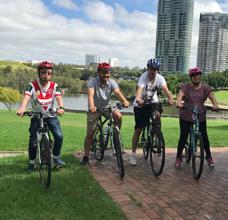


Thank you to Queensland Police for your incredible efforts in protecting and supporting our communities. Your commitment, bravery and care are deeply appreciated. Keep up the amazing work!
Electorate Office:
One Eagle - Waterfront Brisbane, 1 Eagle Street, Brisbane QLD 4000 GPO Box 228, Brisbane QLD 4300 senator.roberts@aph.gov.au
Tel: (07) 3221 9099
I look forward to meeting you when I

Malcolm Roberts
Senator for Queensland
Authorised by Senator M Roberts 1 Eagle Street, Brisbane QLD 4000

We value the work of the NSW Police in keeping us safe throughout the year.
Your continued commitment and sacri ce, especially during the Christmas season is much appreciated.
I wish police o cers in my electorate of Bankstown, and police o cers across New South Wales and their families the very best during this special time of year.
Member for Bankstown
Minister for Customer Service and Digital Government Minister for Emergency Services Minister for Youth Justice

Shop 21 Broadway Plaza Punchbowl NSW 2196
P: 9759 5000 F: 9759 1945 E: Bankstown@parliament.nsw.gov.au








February 2, 2024
journals.sagepub.com

Abstract
Livestreaming of child sexual abuse (LSCSA) is an established form of online child sexual exploitation and abuse (OCSEA). However, only a limited body of research has examined this issue. The Covid-19 pandemic has accelerated internet use and user knowledge of livestreaming services emphasising the importance of understanding this crime. In this scoping review, existing literature was brought together through an iterative search of eight databases containing peer-reviewed journal articles, as well as grey literature. Records were eligible for inclusion if the primary focus was on livestream technology and OCSEA, the child being defined as eighteen years or younger. Fourteen of the 2,218 records were selected. The data were charted and divided into four
categories: victims, offenders, legislation, and technology.
Limited research, differences in terminology, study design, and population inclusion criteria present a challenge to drawing general conclusions on the current state of LSCSA. The records show that victims are predominantly female. The average livestream offender was found to be older than the average online child sexual abuse offender. Therefore, it is unclear whether the findings are representative of the global population of livestream offenders. Furthermore, there appears to be a gap in what the records show on platforms and payment services used and current digital trends. The lack of a legal definition and privacy considerations pose a challenge to investigation, detection, and prosecution. The available data allow some insights into a potentially much larger issue.
“The internet and mobile technology make possible the online viewing, distribution, and storing of child sexual exploitation material (CSEM) (Steel et al., 2020)”

On behalf of the Coffs Harbour electorate I would like to honour all members of the NSW Police Force who have lost their lives in the line of duty.

A: 331 High Street, Penrith NSW 2750 (02) 4722 0600 f: MelissaMcIntoshMP E: melissa.mcintosh.mp@aph.gov.au W: melissamcintosh.com.au

Member for Coffs Harbour Shadow Minister for Tourism, Emergency Services and the North Coast coffsharbour@parliament.nsw.gov.au (02) 6652 6500

We honour the sacrifice of our Police Officers, who have lost their lives in the line of duty. We honour the sacrifice of our police officers, who have given their lives in the line of duty.


My gratitude to the brave men and women of our police forces who have passed in the line of duty. Their courage and dedication will never be forgotten.


Over the past three decades, the internet has evolved to become an essential tool to connect, sell, and inform, changing society as a whole, and with that, the scale and opportunities for committing internet-related crimes such as child abuse online ( Wolak, 2004). The internet and mobile technology make possible the online viewing, distribution, and storing of child sexual exploitation material (CSEM) (Steel et al., 2020). Several offenses fit under the umbrella term of online child sexual exploitation and abuse (OCSEA), such as the production, dissemination, and possession of CSEM; online grooming; “sexting”; “sextortion”; revenge pornography; commercial sexual exploitation of children; exploitation through online prostitution; and the livestreaming of sexual abuse (Quayle, 2016). This review focuses specifically on the livestreaming of child sexual abuse (LSCSA), which is the real-time producing, broadcasting, and viewing of child sexual abuse and is related to sexual exploitation through prostitution, sexual performances, and producing CSEM (ECPAT, 2016). Unlike other forms of CSEM, such as images or videos, the LSCSA is the real-time production of child sexual abuse, which means that there is a potential to stop the abuse and protect the child while the abuse is occurring. Therefore, it is necessary to gain a better understanding of the issue and assess which tools are needed so that this abuse can be stopped or, in the best case restricted from happening at all. LSCSA is considered an established crime (European Financial Coalition against Commercial Sexual Exploitation of Children Online, 2015), and can refer to both commercial and non-commercial use, yet is perhaps most known for cases where the purpose is to exploit the child sexually for financial gain. A remote offender can view and direct the sexual activities online; in some cases, a facilitator arranges the abuse on site (European Financial Coalition against Commercial Sexual Exploitation of Children Online, 2015). The financial element leads LSCSA to be considered a form of commercial sexual exploitation of children, or child trafficking. Further, self-generated sexual content involving children and adolescents can also be a form of LSCSA. In these cases, there is not always a financial element present or a facilitator.
Several studies have looked at internet-facilitated sex offenses and commercial sexual exploitation with the internet as a facilitative tool or platform for the production, purchasing, and selling of CSEM or online live sexual content and the establishment of contact between the child and offender (Jonsson et al., 2014; Mitchell et al., 2011). However, limited studies have looked specifically at livestreaming technology as a service to facilitate the online sexual abuse and exploitation of children and adolescents, which is notable, as the technology has been used by offenders for at least two decades. In 2001, it was reported that web cameras were used to facilitate child sexual exploitation and abuse through live transmission (Hughes, 2001; 2002). Mitchell et al. (2011) state that 5% of offenders arrested in 2006 for internet-facilitated commercial sexual exploitation of children in the United States had watched live sexual activity containing minors using the internet. In 2008, a study by Shannon examined the extent and character of online sexual grooming in Sweden and identified web cameras as a tool used by offenders. Images were saved and used as blackmail, also known as sextortion, to obtain more images or to coerce the child to provide live sexual content using a web camera (Shannon, 2008). Multiple court cases from the Netherlands show that in 2009 web cameras were used by adults to extort young children to perform sexual activities (Koops, 2009). These studies have included the component of livestreaming in their investigations and analysis, often referring to the web camera as a tool. However, studies with empirical data on LSCSA with a web camera or other devices are limited (Koops et al., 2018).
Livestreaming is the term for operations or technology that allows recording and broadcasting over the internet in real time (Hamidouche et al., 2022). The main technical steps in a livestreaming pipeline are compression, encoding, segmentation, distribution, caching, decoding, and video playback. Current solutions are argued to be both cost-effective and easy to use without a need for complex separate setups (Fecheyr-Lippens, 2010). Almost every social media platform allows personto-person livestreaming in one way or
another (Facebook live, TikTok live). This is also true for (1) message apps like WhatsApp, Discord, and Facebook Messenger; (2) specific services focused on livestreaming like Twitch and Omegle; and (3) video call software that has become common during the Covid-19 pandemic such as Microsoft Teams, Zoom, and Google Meet. The terms web cams or web cameras were used early in the video streaming age, but now, however, technology enabling livestreaming includes anything with a camera and a network connection, ranging from high-end professional cameras to computer cameras, mobile phones, and other internet of things devices such as glasses, watches, and drones. Finally, it is interesting to note that from a user perspective, livestreaming has not changed significantly in recent years, besides better video quality, a better experience with no delays, and easier accessibility.
Over the last few years, an increase in LSCSA has been noted ( Virtual Global Taskforce, 2019). The COVID-19 pandemic has accelerated the use of digital technology worldwide, and Europol (2020b) found that LSCSA has increased and become more prevalent during the pandemic. Moreover, they note that in cases of OCSEA, it was expected that LSCSA would increase while travel was restricted and borders closed (Europol, 2020b).
The Canadian National Child Exploitation Crime Centre recently stated that “with the pandemic we have seen an uptick in livestreaming with overseas victims” (Somos, 2022). In the Philippines, which is described as the global epicenter of the livestream sexual abuse trade (Brown, 2016), a significant increase in child sexual abuse cases were reported during the first months of Covid-19 compared to the year before (Pulta, 2020). In addition, the amount of self-generated sexual content featuring children enabled by livestream services has been rising (Internet Watch Foundation, 2020). On the demand side, Europol (2020a) found a significant increase of interest in video captures (“cappers”) of LSCSA on dark web forums. Considering this increase in the use of livestreaming technology, accelerated by the Covid-19 pandemic, and the continued on page 49










corresponding rise in cases of OCSEA, it is critical to understand better the unique characteristics of LSCSA. In this scoping review, we present the relevant literature and examine the range and nature of the evidence on LSCSA by answering the following research question: What are the characteristics of LSCSA; who are the victims and offenders; and what are the enabling technologies? Our aim is that these findings will present an overview of the evidence and address the gap in the literature on LSCSA which can direct future research.
To answer the research question a scoping review was conducted. Scoping reviews are used to scope the extent, range, and nature of the evidence and identify research gaps while following a systematic approach ( Tricco et al., 2018). Furthermore, scoping reviews lend themselves especially well to emerging fields and for organising and summarising heterogeneous evidence without evaluating the quality of the studies. This scoping review explores the literature and brings together the emerging evidence on LSCSA. The Joanna Briggs Institute (JBI) framework for scoping reviews and the PRISMA Extension for Scoping Reviews checklist have been utilised to ensure the quality and transparency of the review conducted offering guidance in developing a research question, inclusion, and exclusion criteria, extracting, and charting the results, and discussing these with their implications for future work (Peters et al., 2020; Tricco et al., 2018).
We used the three-step search method suggested by the JBI to ensure a comprehensive search strategy. First, a wide selection of databases was selected to gather the data and to ensure adequate coverage of the literature to minimise publication bias. Records were identified using iterative searches of ACM Digital Libraries, EBSCOhost Academic Search Complete, , IEEE Explore, ProQuest, PsychINFO, Springer, and in June 2021. Search strategies and terminology were modified as necessary for each database. Second, we searched for keywords and used three separate elements: child, abuse, and livestreaming technology. Then we added synonyms. These three elements were then combined in the search,
which yielded results. Table 1 shows an example of the electronic search strategy for the PsychINFO database. Third, the references of the included articles were screened to retrieve documents and studies both in and outside of scholarly literature. Records that were eligible for inclusion had to meet several criteria. (1) A primary focus on the phenomena of interest: livestream technology and OCSEA. Due to the nature of a scoping review, the criteria were not given additional descriptors as this would have narrowed the scope too much. Records that did not focus on live streaming as a means for online child sexual abuse were excluded. As an example, some nongovernmental reports that were selected had a focus on online child sexual abuse in the Philippines which is known to have many cases of LCSA; however, because there was no specific focus on the livestreaming element of child sexual abuse, these were excluded. (2) The victim was defined as a child or adolescent 18 years or younger according to the Convention on the Rights of the Child (United Nations, 1989). For example, one study included victims who surpassed the age of eighteen due to recording practices of law enforcement. Even though this was the case in a limited number of cases, the study was excluded. For offenders, no particular age was set as a criterion. (3) Newspaper articles, bachelor and master theses were excluded, and all other documents were included. (4) The included records had to be written in Danish, English, Norwegian, or Swedish. There were no criteria set on methodology, or year of publication.
A protocol was developed based on the Reporting Items for Systematic Reviews and Meta-Analyses Extension for Scoping Reviews (PRISMA-ScR) Checklist ( Tricco et al., 2018). This protocol functioned as a guide to make clear and consistent decisions as a team and was uploaded in the Open Science Framework under DOI 10.17605/OSF.IO/G6EUB. The titles and abstracts of the records (n = 2,218) were screened by at least two independent researchers. Similarly, two independent researchers screened the full texts (n = 93). Data were extracted, and summaries were made of each of the records. Where there were conflicts, a discussion was held with the members of the team to decide on either inclusion or exclusion.

Seventy-nine records were excluded because they did not meet the two criteria of having a primary focus on livestreaming of online child sexual abuse and the child being defined as 18 or younger. A total of 14 records were identified for inclusion, see Figure 1 for the PRISMA flowchart. A data-charting form was jointly developed by the reviewers to determine which variables to extract. These included the author(s), year of publication, location, language, aims of the study or record and main area of focus, methodology, important findings, technological definitions, terms used throughout the record, and policy recommendations. The results were identified and organised by content and listed in Table 2, which shows the dominant areas of research in terms of the research topic, method, and geographical location of the data. Four primary categories were identified: victims, offenders, legislation, and technology (technical challenges and solutions concerning livestreaming). There are substantial overlaps within these records, as they often touch on several of the categories. Using the four mentioned categories provided a framework to organise these findings in a systematic way.
The 14 records included eight peer-reviewed articles, a PhD study, a book chapter, and four reports by nongovernmental organisations (Table 2). In the section below these findings are categorised into the four categories of interest: victims, offenders, legislation, and technology to discuss the characteristics of LSCSA. It is important to note that most of the data in the victim and offender categories are based on cases from the Philippines. Further, four of the empirical studies are interrelated (Brown et al, 2020; Cubitt et al., 2021: Napier et al., 2021a, 2021b). For a summary of the most critical findings, see Table 3
Most of the records included in the review describe the characteristics of the victim and the process of victimisation. Only one record presented some of the psychological effects live streaming of child sexual abuse has on its victims. These are all key components to a better understanding of the LSCSA. The ages of the victims ranged from 7 to 17, and the victims were predominantly female (Internet Watch Foundation, 2018; Napier
continued on page 54

(child* or baby or babies or infant* or newborn* or toddler* or youth* or young* or preteen* or pre-teen* or Teen* or adolescent* or kid* or pre-pub* or prepub* or pre pub* or pubescent* or pubert* or post-pub* or post pub* or postpub* or peer* or juvenil* or underage* or minor* or boy* or girl*).mp.
(stream* or (live adj2 (stream* or video* or distance or broadcast* or online* or footage or webcast* or image* or feed* or transmission* or video communication*)) or videocast* or on demand or webcam* or web cam* or web-cam* or ((indecent or inappropriate) adj2 video*) or (online adj2 child adj2 sex*)).mp.
(danish


Additional records identified via references (n=24)
Records identified via Database searching (n=2194)
Records screened via title and abstract review (n=2218)
Records excluded (n=2125)
Records evaluated via full text review (n=93)
Records excluded following full text review (n=79)
No primary focus LSCSA (n=59)
Newspaper articles (n=7)
Master thesis (n=4)
Bachelor thesis (n=2)
Not in Danish, English, Norwegian, or Swedish (n=2)
No access (n=2)
Sample included victims over the age of 18 (n=2) Power point presentation (n=1)
Included
Records included in review (n=14)

Terre des Hommes (2013) (1) In-depth interviews with victims, their families and community members. (2) A combination of a semistructured interview and a structured questionnaire.
Terre des Hommes (2014)
Açar (2017)
Online field research interacting with 20,172 offenders on 19 chat rooms over a ten-week period.
Discussion of current and futuristic methods of detection.
Varrella (2017) Discussion of definition, causes, consequences, and the existing legislative international and national frameworks.
Internet Watch Foundation (2018)
Content analysis of images from a sample of captures of livestreamed child sexual abuse available online.
Horsman (2018a) Examination of the forensic procedures required reconstruction of web-browser cached video data from YouTube and Facebook streaming services.
Horsman (2018b) Investigation of the challenges posed by the livestreaming platform “Periscope” in order to reconstruct cached data.
Horsman (2019) An analysis of video stream reconstruction using web-browser cache data from the Twitch, Youtube, Mixer, Ustream, Smashcast, and Younow livestream services.
Dushi (2019) A comparative legal analysis between Italy, and England & Wales.
Dushi (2020) Discussion on the current existing legislation and its implications on the crime of livestreaming child sexual abuse.
Brown et al. (2020)*
Analysis of financial transactions of Australian-based individuals to known livestreaming facilitators in the Philippines. (Based on the same data source as used in Cubitt et al., 2021).
Cubitt et al. (2021)* Analysis of financial transactions of Australian-based individuals, using machine learning, to identify characteristics of prolific livestream offenders. (Based on the same data source as used in Brown et al., 2020).
Napier et al. (2021a)* Analysis of chat logs from offenders who watched and directed the sexual abuse of children via livestream. (Based on the same data as used in Napier et al., 2021b).
Napier et al. (2021b)*
Analysis of chat logs of offenders committing child sexual abuse livestreaming offences. (Based on the same data as used in Napier et al., 2021a).
Table 2. Overview of Included Records
*The four studies are conducted at the Australian Institute of Criminology and for some the same dataset is used.
Victims
Offender
Legislation
Technology
Overall/ general
* The victims are mostly female. *Victims are manipulated into participating rather than being forced because they know their abuser. * Victims also contact offenders themselves with the motivation to earn money. *Victims report feeling shame, fear, and embarrassment and suffer from high levels of psychosocial distress. *The material of the abuse is spread which makes for revictimization.
* The offender is considered to be a facilitator of the abuse and/or the person viewing or ordering the livestream. * The livestreaming offender is generally older than other online offenders. * Some offences were opportunistic in nature. * The offender used well-established platforms for both making contact and streaming. * Offenders usually payed with well-established money transferring systems.
* Livestreaming of child sexual abuse is not a stand-alone offence and has no legal definition which creates challenges in conviction of the crime. * The lack of a common definition also challenges the scientific work.
* Detection is difficult. * Privacy regulations make the creation of regulations and laws challenging. * There might be a big gap between the services that are known to be used and the number of services that are used (Table A1 in the Supplemental Appendix). * Livestreaming is built in almost every social interaction platform existing.
* There is lack of consistency in definitions and operationalizations across studies in the literature. This challenges the comparison and generalization of the findings and applicability must be carefully examined.
Note. Reviewed 14 records. The findings were divided into four different categories: victim, offender, legislation, and technology.
Table 3. Critical Findings
256 individuals and 2,714 transactions
207 individuals
7 offenders and 74 victims
7 offenders, 145 offences and 74 victims
Practice
Policy

Future research
* Practitioners need to be aware of the online components in child sexual abuse cases. *Inclusive and gender- sensitive research of the psychological consequences and trauma and the effect on disclosure is needed to adequately meet the specific needs and care for victims of LSCSA.
* Policymakers must be made aware of the rising threat livestreaming services present. * Policymakers should work on making companies accountable for the platforms they provide. * Create a legal framework and definition for LSCSA. * Review both international and national legal frameworks. *Facilitate interdisciplinary collaborations.
* Focus on other geographical locations with high poverty rates, access to technology and high English proficiency levels to study the prevalence of livestreaming of child sexual abuse. * Focus research on self-generated sexual content featuring children and adolescents. * Focus research on technical trends within livestreaming services to understand the prevalence of LSCSA.
Note. LSCSA = livestreaming of child sexual abuse.
Table 4. Implications for Practice, Policy, and Future Research

et al., 2021a; Terre des Hommes, 2013). Three models of operation have been identified in the LSCSA ( Terre des Hommes, 2013). However, it is important to note that these models of operation are based only on data from the Philippines. (1) “The individual operation” in which a child voluntarily performs sexual acts on camera for foreign viewers in exchange for money. Note that this child is considered a victim and that it is often not clear to what extent the child is coerced. (2) “Family-run operations” that most often involve either parents or family members coercing the child to perform sexual acts on camera in exchange for money. (3) “Cybersex dens” in which several children are either hired or trafficked and kept against their will in a location to perform sexual acts on camera ( Terre des Hommes, 2013).
Victimisation refers to the process of becoming a victim of LSCSA. Although the Philippines is considered the hotspot of the LSCSA (Brown, 2016), the records show that victims are also located in other parts of the world. Out of 74 victims identified in Napier et al. (2021a), 43 were from the Philippines, while two were located in the United Kingdom, two in China, and one victim was in Thailand. Of the remaining 26 victims, the location was unknown. The Australian offenders also attempted to establish online contact and groom children from Australia, Indonesia, Vietnam, Japan, and Namibia (Napier et al., 2021a). Furthermore, the Internet Watch Foundation (2018) found that victims are mostly white females from relatively wealthy Western backgrounds. This indicates that victimisation takes place globally. Family members, peers, and community members have a significant role in persuading or manipulating a child into participating in LSCSA ( Terre des Hommes, 2013). These people related to the child either facilitate or participate in the abuse. The facilitator was often found to be a relative of the victim, most commonly their mother or sister (Napier et al., 2021b). Due to this type of family involvement, the child is not necessarily physically forced to participate, but simply obeys the parent or is manipulated into participating. This is supported by earlier findings that most children who appear in CSEM have not been physically forced to participate.
Instead, they were often manipulated into participating because they knew the person facilitating the abuse ( Worthley & Smallbone, 2006). Almost half of the victims have family members who are themselves involved in LSCSA or are aware of the child’s involvement in sexual activities on the web camera, which suggests a degree of normalisation within the community ( Terre des Hommes, 2013). Poverty is considered one of the main driving forces behind the LSCSA (Brown, 2016; Hernandez et al., 2018; Varrella, 2017). Most of the studies in this review are based on data from the Philippines, where poverty levels are high—about 24% were living below the poverty threshold during the first half of 2021 (Philippine Statistics Authority, 2021). LSCSA is perceived as relatively harmless because in some cases there is the absence of contact abuse. Moreover, it is considered an easy way to provide income for the family ( Terre des Hommes, 2013; Varrella, 2017). In addition, children in these environments are often expected to help provide an income for the family, especially when there is a lack of basic needs (UNICEF, 2021). There are also cases where children themselves reach out to foreigners, without their parents’ knowledge. In these cases, the child is either pressured or lured by peers and learns to establish contact with a foreigner through their network of friends. The motivation is often to provide an income for their family or themselves ( Terre des Hommes, 2013). Two common methods are identified for how offenders have targeted their victims: (1) by contacting women and teenagers online to establish relationships, whereafter the offender would request access to younger children or be offered access; and (2) by establishing relationships with families while visiting the Philippines for work. Upon return, they would request CSEM and LSCSA (Napier et al., 2021b; Terre des Hommes, 2013). Even though this type of abuse often includes a facilitating person, in twothirds of the analysed cases, offenders communicated directly with their victims (Napier et al., 2021b). Sometimes grooming tactics were used, such as “providing compliments,” “using romantic language,” and “asking inappropriate or personal questions” (Napier et al., 2021b, p.12; Terre des Hommes, 2013). Offenders would build relationships with the facilitator and victims by promising
education for the child, payment of tuition fees, or payment for other material needs in return for participation in LSCSA ( Terre des Hommes, 2013).
Psychosocial consequences
Terre des Hommes (2013) interviewed 44 children from the Philippines who were involved in livestreamed sexual abuse or had been rescued. Regarding the psychosocial consequences, victims reported feelings of shame, fear, and embarrassment. The victims suffered from high levels of psychosocial distress such as traumatic sexualisation, betrayal, social stigmatisation, and powerlessness as defined by the traumagenic dynamics model by Browne and Finkelhor (1986) for understanding the trauma of sexual abuse. The traumatic effects on the victims were severe due to the involvement of their parents and included feelings of confusion and conflict of loyalty ( Terre des Hommes, 2013). This presents challenges for the disclosure of the crime and the child’s psychological recovery, as they will have to learn that their parent has committed a crime and might be incarcerated for the offence ( Terre des Hommes 2013). A common finding throughout the literature is that children are less likely to disclose sexual abuse when the victim is close to the offender (Hershkowitz et al., 2014) and when motivational factors such as negative emotions and concerns of legal consequences to family members are present (Malloy et al., 2011). However, these experiences are not necessarily unique to the LSCSA since, for other types of online child sexual abuse, parents were also found to be facilitators and offenders (Mitchell et al., 2011). Family reintegration is challenging due to the risk of revictimisation and the fact that family and community members either actively took part in or tolerated the crime and failed to protect the child. Another type of revictimisation, that has been noted for OCSEA, is the online spreading of CSEM. Once an image is online, the “image exists out of the subject’s control for the remainder of his or her life” (Quayle & Sinclair, 2012, p. 15). This also applies to other content on the internet such as videos. Although it is argued that livestreaming leaves no trace due to the live transmission component, the records suggest that screen captures or cappers are taken, redistributed, and stored just as with images and videos (Europol,
2020a; Internet Watch Foundation, 2018; Varrella, 2017). Interestingly, the Internet Watch Foundation (2018) did not find any captures of livestreaming made available to remote buyers in their search of the surface web. This could support the claim by Varrella (2017) that the material can be disseminated through the dark web or other private networks (Internet Watch Foundation, 2018). Cappers from livestreamed abuse are often uploaded to cyberlocker sites. These sites help to commercialise the provision of content by paying the uploader per download from the contentproviding cyberlocker. The links to these cyberlockers are distributed within dedicated online forums that often use images of child sexual abuse or captures to promote downloads to those interested in CSEM (Internet Watch Foundation, 2018). Some of the content when located can be removed from an online location. However, it cannot be removed entirely, and the victim must live with this reality.
This section presents the findings regarding offenders of LSCSA, including offender characteristics, and the enabling platforms. There is a distinction between different types of offenders, and the records use different terminology in their descriptions. The person who views, directs, and pays for the LSCSA is often referred to as either the “customer,” “perpetrator,” “client,” “consumer,” “offender,” or “predator.” If there are people “on-site” facilitating the exploitation and abuse, they are referred to as the “facilitator,” “operator,” “middleman,” “pimp,” or “trafficker.” However, not all cases have a facilitator, for example when the abuse is selfgenerated. Furthermore, the facilitator can also be the offender (Napier et al., 2021b). These differences in terminology make it challenging to compare the data.
Regarding the characteristics, Cubitt et al. (2021) analysed the age of offenders of LSCSA and found that ages ranged from 20 to 76 years, and the average age of the offender was 52 years. Other studies have shown a range of between 50 and 60 years and 42 and 72 years of age (Brown et al., 2020; Napier et al., 2021a). These studies have used the same data source to some extent, and it is therefore unclear if there is any overlap
in their findings. A distinction was made between low-volume and high-volume offenders (Cubitt et al., 2021). Highvolume offenders were the 10% of the data sample with the highest number of transactions. The study used machine learning to predict the characteristics of prolific LSCSA offenders and found that offenders who made more than one transaction showed a decline in time between transactions, which was confirmed by Brown et al. (2020) With the increase in the frequency of transactions, the severity of the offending also increased (Brown et al., 2020). Highvolume offenders appear to make lowvalue transactions, but more frequently. It was unlikely that an offender would spend more than 250 USD in a single transaction. The study’s authors raise the question of whether this is a strategy to avoid detection. In addition, the study looked at the criminal records of these offenders and found that a history of lowharm offending was common. Prior sex offences were not a significant predictor of prolific livestreaming (Cubitt et al., 2021). Further, a number of the offences were “opportunistic in nature” (Napier et al., 2021b, p.14); for example, the offender was offered an opportunity to watch child sexual abuse while initially paying for adult women to perform sexual acts.
Technical platforms and payment
Most offences have been committed on the surface web using computers (personal or public), laptops, tablets, and mobile phones (Napier et al., 2021a; Terre des Hommes, 2013).
Furthermore, the records find that wellestablished platforms are used to initiate contact via chat and to facilitate and view LSCSA: Facebook (Messenger), Yahoo! Messenger, text messages, Skype, and Viber (Napier et al., 2021a; Terre des Hommes, 2013). Negotiation of the price and method of payment was common and established prior to streaming, typically using online chat (Napier et al., 2021a). Various factors determine the price: the victim’s age, the extremity of the abuse, the length of the stream, and the number of children involved ( Terre des Hommes, 2013; Varrella, 2017).
The Philippines has a well-established money-transferring system, and remittance services are a common way to send and receive money ( Varrella, 2017). The most popular services are Western Union, WorldRemit, Remitly, and PayPal

which provide more anonymity (Napier et al., 2021a; Terre des Hommes, 2014). Theprices for LSCSA per show are generally not very high, ranging from $10 to $50 USD ( Terre des Hommes, 2013; Varrella, 2017). However, in some cases the amount was higher but not exceeding $404 AUD which is the equivalent to around $250 USD (Napier et al., 2021a). Higher payments were an indication of the personal involvement of the offender in the children’s lives.
It is argued that existing laws do not adequately address the specific offence of livestreaming (Dushi, 2020). LSCSA is not a stand-alone offence, and criminal courts have used other provisions to criminalise the LSCSA, such as child pornography, child prostitution, and rape (Dushi, 2020). To adequately protect children in the online environment, legislation should “enable to identify, locate, investigate, and prosecute online offenders” of LSCSA (Dushi, 2020, p.220). Although there are national laws and international instruments1 addressing OCSEA, they fail to sufficiently address the criminal acts of LSCSA (Dushi, 2020). However, they do present a framework for creating comprehensive new legislation addressing OCSEA more explicitly (Dushi, 2019, 2020). When national laws and international instruments are not harmonised, legal loopholes can appear. The absence of harmonized legislation can also lead countries, judges, and courts to interpret the same instruments differently (Dushi, 2019, 2020).
This makes cross-border collaboration challenging and affects scientific research, as many definitions are used because of the lack of agreement upon legal terms. In the literature, LSCSA is also referred to as “live online child sexual abuse,” or “child sexual abuse to order” (ECPAT, 2016), “live distant child abuse” (Europol, 2015), “pay-per-view,” “on-demand child sexual abuse” (Ramiro et al., 2019), “webcam child sex tourism” ( Terre des Hommes, 2013), or “webcam child prostitution” (Açar, 2017).
In addition to these legal challenges, there are challenges related to creating and using technical solutions to investigate and detect LSCSA as well. Terre des Hommes (2014) argued for adopting proactive law enforcement policies, creating policies and legislation
continued on page 57

As we commemorate the police officers who have made the ultimate





Blacktown City Council is committed to working towards a community based on equality and respect to ensure that every person has the right to live a safe and meaningful lie, free from all forms of violence.
Blacktown City Council is committed to working towards a community based on equality and respect to ensure that every person has the right to live a safe and meaningful life, free from all forms of violence.
Blacktown City Council is committed to working towards a community based on equality and respect to ensure that every person has the right to live a safe and meaningful lie, free from all forms of violence.
Council applauds the outstanding police officers at Blacktown, Mount Druitt, and Quakers Hill Local Area Commands.
Council applauds the outstanding police officers at Blacktown, Mount Druitt, and Quakers Hill Local Area Commands.
We are proud to work in partnership with our local police to help make Blacktown City a safe place to live, work and enjoy.
We are proud to work in partnership with our local police to help make Blacktown City a safe place to live, work and enjoy.













that enable law enforcement agencies to patrol public online spaces. Their study used an automated chatbot, an artificial intelligence feature that simulates human conversation through, for example, text-chat. In this case, the chatbot was a 10-year-old Filipino girl called Sweetie. The chats identified individuals seeking to engage in LSCSA in 19 chatrooms. Although the researchers interacted with 20,172 offenders and identified 1,000 offenders from 71 different countries, using chatbots to perform this type of investigative work is legally and ethically challenging. Açar (2017) examined different technologies that can be used to detect LSCSA. Fully automated chatbots such as the abovementioned Sweetie 2.0, utilising big data analysis of meta-data and analysis of content data provided by Voice-over-IP companies, to avoid having to rely on human reporting, are discussed. This, however, is intrusive, violates privacy, and will require changes of laws and rules. The technical difficulties are solvable, but the real challenges lie in legal and sociopsychological complications.
From a technical perspective, it is very difficult or even impossible to detect and observe livestreamed abuse from the outside (usually such a livestream is performed in a secured environment, an encrypted connection, between two or more parties).
However, Horsman (2018b) presents a method for investigating live streams in Periscope (Twitter’s livestream service). Live analysis is necessary to identify abusers and is done with full internet access and access to the service. Thus, for live access, two different sides exist: the victims and the offenders. For the live analysis, access to the account and perhaps even the device is needed to extract information. If only the victim’s side is known, cooperation from the provider is necessary to determine if the offender made a fake profile. Thus, with only the victim’s perspective and information the victim can provide, enforcement of a sexual abuse offence involving a livestream video is practically difficult. It is challenging to find concrete evidence of the usage of a live sexual abuse case. The information that can be extracted might also differ between different devices. Live access and live analysis are needed to obtain information that can be used legislatively. This might be impossible depending
on the devices used. The Horsman study was performed with Periscope only, but these findings are likely valid for all livestream services. One way to investigate livestreamed videos is by looking at cached content on the devices of the victim or offender as discussed by Horsman (2018a). Reconstructing videos after they are streamed is one way to investigate live sexual abuse. Rebuilding from cached video stream data is necessary. Cached metadata for video stream files are needed to determine the order. If this is not available, the task becomes unfeasible and perhaps even impossible because of the many different files. Viewing recorded livestreaming leads to cached content from all platforms investigated by Horsman (2019) in a follow-up study. However, livestream broadcasts are only cached for four of six services (i.e., Twitch and YouNow do not support this). In general, further work is needed to obtain a better understanding of the technical challenges and the differences between the platforms. Forensics is at the beginning of investigating livestreams and the different platforms, and it is challenging to reconstruct and find content. Browsing history and cached content need to be combined to allow proper investigation. Content providers could help make the task easier, but governmental rules or laws will be needed to achieve this. Machine learning might be a useful tool in making the task more feasible.
On the other hand, despite the possibility of recreating data from web-browser caches and finding usernames in the metadata (Horsman, 2018a, 2018b), application providers are also building support in their systems for a user to stay “private.” For example, a technical issue is that many modern browsers support what is called “private mode” where all browsing history and content is removed as soon as the window closes. Thus, all the evidence will automatically be deleted, or not be accessible at all as in many mobile apps. This presents a great challenge in making legislation, rules, and laws to regulate this. As noted above, an efficient detection of online sexual child exploitation and abuse may require full access to the server, network, and client systems, but this goes against the principles of enabling full privacy.

This scoping review identified 14 records. The included records had a primary focus on livestreaming of online child sexual abuse, the child being defined as 18 years or younger. This study included peer-reviewed journal articles as well as grey literature. No rating of the quality of evidence is provided but an overview of the evidence is presented. No general conclusions can be drawn about the current state of LSCSA on an aggregated, global level. Arguably, most studies are more informative when looking only at the Philippines. A major limitation is that there is no agreed-upon legal term for the LSCSA. Further, the variety of study designs, research questions, and variable operationalisation such as distinctions between facilitators and offenders, made it challenging to retrieve relevant data and for future studies to compare these data. In addition, the study samples were relatively small making the findings non-generalisable.
Gender and cultural dimensions may influence what is observed in the data. For instance, most victims of LSCSA represented in the data were female. This could either reflect that victims of LSCSA are predominantly female or that male victims are underrepresented in the data. In fact, studies on child sexual abuse suggest that male victims tend to delay the disclosure of sexual abuse which could explain the observed numbers (Gagnier & Collin-Vézina, 2016). This is therefore an important area of further study. Conducting research that is inclusive and gender sensitive will affect the identification, treatment, and support of the victim. The data on the LSCSA primarily originate from the Philippines. The Philippines is referred to as “the global epicentre of the livestream sexual abuse trade” (Brown, 2016, p.1), as most of their cases of online child sexual abuse are enabled through livestream services (Europol, 2019; International Justice Mission, 2020). Poverty, challenging economic conditions, and high levels of English language proficiency are considered the main reasons for this (Brown, 2016). However, several cases in other countries have been reported (Europol, 2020a). The Internet Watch Foundation (2018) found that victims were mostly
continued on page 58

white females and from relatively wealthy Western backgrounds. This suggests that different forms of LSCSA may exist in different geographical locations although this is not fully reflected in the data. The question is whether LSCSA is occurring primarily in the Philippines or if we are seeing the tip of the iceberg of a globally widespread issue. Although the data in the records provide no clear answer to this question, one can clearly observe that countries such as China, India, Japan, and Brazil recognise the problem and have started their own respective counterprograms. This is also the case for the European Union, which recently released a proposal laying down rules to prevent and combat child sexual abuse, which is also connected to the strategy of a better internet for kids (European Commission, 2022a, 2022b). The proposal has specific definitions for online live abuse including actual and simulated sexually explicit conduct.
The data contained both cases of LSCSA with a facilitator as well as selfgenerated sexual content featuring children enabled by livestream services. The latter is also found to be rising (Internet Watch Foundation, 2020). In cases of self-generated sexual content featuring children, it is often challenging to evaluate the level of coercion, as some of the young individuals are using streaming services to self-exploit, earn money and receive gifts, or receive “likes” (Internet Watch Foundation, 2018; Jonsson et al., 2014; Terre des Hommes, 2013). In addition, it is not always clear whether a crime is taking place or if (sexual) boundaries are being explored between youth (Koops, 2009). This makes for complex legal challenges as the child can be both considered the offender and the victim ( Westlake, 2018). While there is a discussion about the definition of selfgenerated sexual content featuring children and the extent to which someone is coerced, this group, especially during this digital acceleration, needs more attention, as the data are limited (Internet Watch Foundation, 2018).
Several records found that the age of the offender is between 50 and 60 years (Brown et al., 2020) and while some studies presented a wider range, the average age of the offender was still within that span (Cubitt et al., 2021). This is interesting because, as noted
in Brown et al. (2020), a meta-analysis by Babchishin et al. (2011) found that the average age of online sex offenders is significantly younger than the age of the average livestreaming offender found in the records included in this review. This raises the question of why there is a difference between these findings. Since the studies in the scope used law enforcement records and financial transactions, the discovered characteristics describe a convicted offender group. Therefore, it is unclear whether offenders of LSCSA typically are older or older offenders are more likely to get convicted. If it is the latter, it could perhaps have something to do with the type of technology utilised. Convicted offenders of CSEM have been found to use well-established technologies rather than being early adopters of new tools (Steel et al., 2020). Less is known about the facilitator, other than that most of them were family members, female and some had experienced abuse themselves (Napier et al, 2021b). Therefore, more research is needed on both the offender and the facilitator.
The findings on payment methods are inconsistent with current trends. Europol (2021a) states that cryptocurrency, a key payment method on the dark web (Heaslip, 2021), is used to pay for LSCSA. In this respect, a cryptocurrency is considered more secure than bank transfers, and it is challenging to trace the identity of the paying customer. This payment method is undoubtedly a means of staying anonymous on the internet. However, it was found that offenders do not often take privacy measures to hide their identity (International Justice Mission, 2020; Balfe et al, 2015). The data provided by the records found that the most utilised payment services are Western Union and remittance services such as WorldRemit or Paypal (Napier et al., 2021a; Terre des Hommes, 2014; Varrella, 2017). This indicates that newer payment methods such as cryptocurrencies are not utilised or that offenders using these services have not been convicted. It is clear that there is a gap between the data presented by the records and the concerns raised by Europol and other law enforcement agencies about the state of LSCSA “facilitated by new technologies” (Europol, 2021b).
Psychological Consequences and Trauma
There is limited evidence on specific psychological consequences and possible trauma-related psychopathology specifically for victims of LSCSA. However, Terre des Hommes (2013) found that these victims suffer from high levels of psychosocial distress, which is in line with the findings of studies that have looked at both offline and online child sexual abuse, that is, not specifically livestreaming. Research suggests that the consequences of OCSEA can be as severe and harmful as offline child sexual abuse (Hamilton-Giachritsis et al., 2017; Jonsson et al., 2019; Whittle et al., 2013). A history of childhood abuse increases the chances of developing emotional and behavioral problems, anxiety, depression, and posttraumatic stress disorder. Further, it increases the risk of poor health outcomes throughout the lifespan (Hailes et al., 2019; Murray et al., 2014). Joleby et al. (2020a) found psychological consequences specifically for victims of OCSEA, including psychological suffering, self-harming and suicidal behavior, internalised selfloathing, and impaired relationships. Furthermore, a common theme was self-blaming, among other adverse effects on the health and well-being of the victims in both the short and long term (Joleby et al., 2020b). In addition, research indicates that for victims, knowledge of images of the abuse existing or having been distributed online was related to higher levels of posttraumatic stress symptoms compared to being exposed to child sexual abuse without it being documented (Jonsson & Svedin, 2017).
The review found that most of the platforms used by facilitators and offenders are relatively few and seem somewhat outdated: Facebook Live, Skype, and Yahoo Messenger (Napier et al., 2021a; Terre des Hommes, 2013). It is interesting that while technology is developing fast, the findings of a study in 2013 and 2021 have similar outcomes regarding the technical platforms used in LSCSA. Although livestreaming is an established technology and has been so for years (Fecheyr-Lippens, 2010), the functionality has developed in terms of the availability of production devices (cameras), consumption
devices (screens), speed, quality (resolution and framerate), stability (no stalling), secure environments, and ease of use. In addition, the COVID-19 pandemic accelerated user knowledge. For comparison, Table A1 in the Supplemental Appendix presents a non-exhaustive overview of some available systems providing livestreaming services today. A key observation is the ease of use of such systems where anyone with any type of device with a camera and microphone, can easily set up a service, and anyone with a simple video app or a vanilla web-browser can receive such streams. Even though many of the livestreaming systems differ slightly in intended use and target user groups, they all provide the same opportunity to set up a livestream easily. Most of the services can be free of charge to a small scale, with a paid option for larger scale setups or higher service guarantees. Nevertheless, the examples show how available today’s technology is to set up both live broadcasts and closed streaming sessions, that is, with the touch of a button. To provide privacy, many of the systems allow private breakout rooms and data (video) encryption, known as end-to-end encryption. It is also possible to be anonymous, both as a producer, making the stream available, and as a consumer, viewing the stream. Alternatively, offenders may use modern cloud services to set up their own video streaming servers. For example, the Amazon Interactive Video Service, Azure Media Services, Google Cloud Video Intelligence Streaming API, or IBM Watson media streaming platform can be used to encode and stream video at large scales, which would be ideal for creating interactive video. Furthermore, as shown in Table A1 in the Supplemental Appendix, the various systems have strict requirements regarding the allowed content. Almost all forbid nudity, adult content, pornography, and any type of child abuse, in particular child sexual abuse material. Most systems also have a lower age limit (typically at least 13 years) to prevent minors from using the service. The terms also typically state that any attempt to break these rules will result in a report sent to law enforcement and the National Centre for Missing and Exploited Children. However, given the various technical properties of the systems,
it is hard to detect these illegal streams. Some systems mention that they have automatic surveillance, for example using Artificial Intelligence, to detect illegal content, but this is immature, and the video content may also be “unreadable” due to encryption. Many details are missing on how automatic detection is done and its possibilities. For example, it is not clear whether the automatically detected content is verified by a human observer. Overall, providing such services for “private events” without being detected is relatively easy. The platforms are not technologically sophisticated and require no specialised technical knowledge for users. Research has found that offenders use both older and newer technologies for online child sexual abuse (Steel et al., 2020). However, the findings of the studies in this review present only the former. Considering the accessibility of different systems and how easy it is to create one’s own stream, it is surprising that none of the records in the scope have detected a wider range of systems used. During the COVID-19 pandemic, internet usage increased by 50% in several European countries (da Silva et al., 2021). Europol (2020a) found there has been “a significant increase in activity relating to child sexual abuse on both the surface web and dark web during the COVID-19 lockdown period” (p. 3). For example, 6 months after the first lockdown in England, a 17% increase in online sexual crimes against children was recorded (Harris et al., 2021). Video streaming, in general, and the use of livestreaming services have risen (da Silva et al., 2021; Statista, 2022). Furthermore, conference calls or video conferencing has become the new norm, using the platforms presented in Table A1 in the Supplemental Appendix such as Zoom, Teams, and Skype. In addition to accessibility and user knowledge, the use of home offices has increased. This environment could provide more privacy and therefore increase the risk of work equipment being used to download or consume CSEM (Netclean, 2020). This increased knowledge and availability could lead to a further increase in the LSCSA in the future. The fact that the abuse is streamed in real time also presents a possibility for the child to be found and rescued which is why more research is needed to further understand LSCSA and develop measures to protect and prosecute.

The review confirmed that there is a limited body of research that has examined this issue of LSCSA. Most of the data stems from the Philippines and is based on a combination of case reports and law enforcement data. Differences in terminology, study design, and inclusion criteria of the population studied present a challenge to drawing general conclusions on the current state of LSCSA. There is no legal definition for LSCSA, and it is not considered a stand-alone crime creating challenges for criminalisation and victim protection. There are limited studies on the psychological consequences for victims. The records indicate that trusted platforms are used to contact the victim or facilitator and view the livestream. Considering the plethora of livestreaming services available today, the records appear to underrepresent this digital development. Similarly, the records point to only a handful of well-established services for payment methods, and do not reveal information on emerging financial technologies such as cryptocurrencies. The average age of a livestreaming offender was found to be older than the average age of online child sexual abuse offenders. Therefore, it is unclear whether the findings represent the global population of livestream offenders or if other factors drive this age difference, such as unfamiliarity with more secure streaming technologies among the older population. In addition, privacy considerations pose a challenge to investigation and detection by law enforcement. This field is in the beginning stages of gathering data, creating knowledge, and understanding the implications for victims and society. It is clear that the available data only provides a small window into a potentially much larger issue.
Although this scoping review was conducted through a systematic process to ensure transparency and rigor, it has several limitations. There is a possibility that the review may have missed other relevant studies. This can have several causes such as the database selection, the definitions used in the searches, and the exclusion of studies published in languages other than Danish, English, Norwegian, and Swedish. In addition, because of the inclusion of grey literature, continued on page 60

which was often found through scanning references, it is possible that significant reports were overlooked. Further, due to the nature of a scoping review, a formal assessment of methodology and a quality assessment of the included reports were not performed. However, it must be noted that a formal assessment falls outside of the scoping review’s scope and focus.
It is essential for practitioners to be aware of the potential online components in child sexual abuse cases and the increasing prevalence of LSCSA. LSCSA can lead to revictimisation when the material (CSEM) is spread online. Research into the psychological consequences and trauma and the effects on disclosure is needed to establish the specific needs and care for victims of LSCSA. It is important this research takes gender and cultural dimensions into account.
Policymakers must be made aware of the rising threat livestreaming services present to society and its children. Policymakers should focus on holding companies accountable for the platforms they provide. What would help in this matter is to create a legal framework and definition for LSCSA and review both international and national legal frameworks so that offenders can be convicted, and the protection and care of the victim established.
There is a clear lack of research on LSCSA, and much of the data stems from cases from the Philippines. Therefore, it would be beneficial to look at other geographical locations to study the prevalence of LSCSA. In addition, it is important to gain a better understanding of the different types of OCSEA facilitated through livestreaming services. In particular, the category of self-generated sexual content featuring children and adolescents is an area where more research is needed. It is argued that a great deal of research on CSEM is done
through retrospective examination, and although valuable insights are provided, little new knowledge is added to assist law enforcement adequately ( Westlake, 2020). This review confirms that the data on LSCSA, with some exceptions, fall in that same category. Even though the technologies used in the cases examined might still be utilised today to some degree, something is likely being missed. It is therefore essential that future research focus on that gap through scientific work. For example, several providers state that they use machine learning (a type of artificial intelligence) to detect anomalies, but the models are still in their infancy, and more work is needed at the same time as access to the data is required (i.e., with all the challenges this will infer). Moreover, interdisciplinary collaborations (law enforcement, the scientific community, tech companies, and children themselves) are at the core of the types of research needed to understand the LSCSA and its developing methods in the future. With the digital acceleration that the COVID19 pandemic has brought upon the world, we must do all we can to protect children from harm and to ensure their digital rights, both online and offline (United Nations, 2021). The implications for practice, policy, and research are presented in Table 4
1. UN Convention on the Rights of the Child, the Optional Protocol to the CRC on the Sale of Children, Child Prostitution, and Child Pornography, the EU Directive 2011/93/EU on combating sexual abuse, sexual exploitation, and child pornography, the Council of Europe Convention for the Protection of Children against Sexual Exploitation and Sexual Abuse No. 201 (Lanzarote Convention), and the Convention on Cybercrime No. 185 (Budapest Convention), and the International Labour Organisation Convention No. 182 on the Worst Forms of Child Labour.


Catharina Drejer is a PhD candidate at Oslo Metropolitan University, Oslo, Norway. She is also working as a lecturer in sociology and human trafficking at the school of Leadership and Theology in Norway. Her research interests include child protection, child welfare, human trafficking, technology, and trauma.
Michael A. Riegler received his PhD degree from the Department of Informatics, University of Oslo, Oslo, Norway. He is currently working as a Chief Research Scientist at SimulaMet, Oslo, Norway. His research interests include machine learning, video analysis and understanding, image processing, image retrieval, crowdsourcing, social computing, and user intentions.
Pål Halvorsen is currently a Chief Research Scientist at SimulaMet, Oslo, Norway, Professor with the Department of Computer Science at Oslo Metropolitan University, and Adjunct Professor at the Department of Informatics at the University of Oslo, Oslo, Norway. His research interests span several areas in distributed (multimedia) systems and content analysis from both a performance and efficiency point of view.
Miriam S. Johnson is a clinical psychologist, associate professor in psychology and research group leader at the Faculty of Health Sciences, Oslo Metropolitan University, Norway. She holds a PhD in witness psychology from the University of Oslo, Norway. Her research interests include forensic- and witness psychology, investigative interviews of alleged victims of child sexual abuse, cognitive development in children, and clinical child psychology.
Gunn Astrid Baugerud is an associate Professor in Psychology & Child Welfare Faculty of Social Sciences, Department of Social Work, Child Welfare and Social Policy Oslo Metropolitan University, Oslo, Norway. He has years of experience studying maltreated and abused children and researching investigative interviews. She has a doctorate in cognitive developmental psychology and degrees in child welfare and psychology.

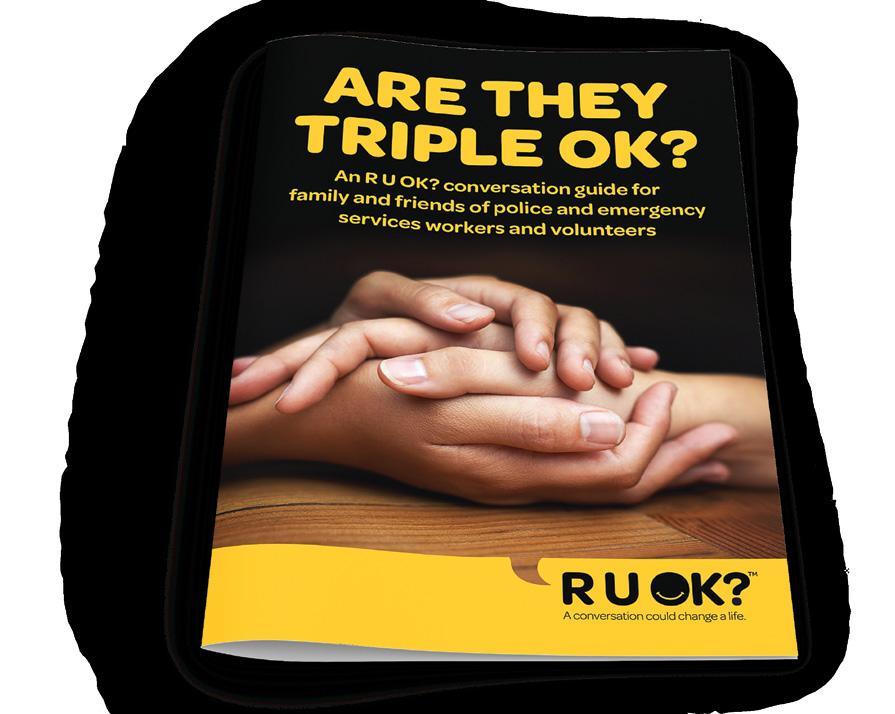
PODCAST NOW STREAMING PODCAST NOW STREAMING
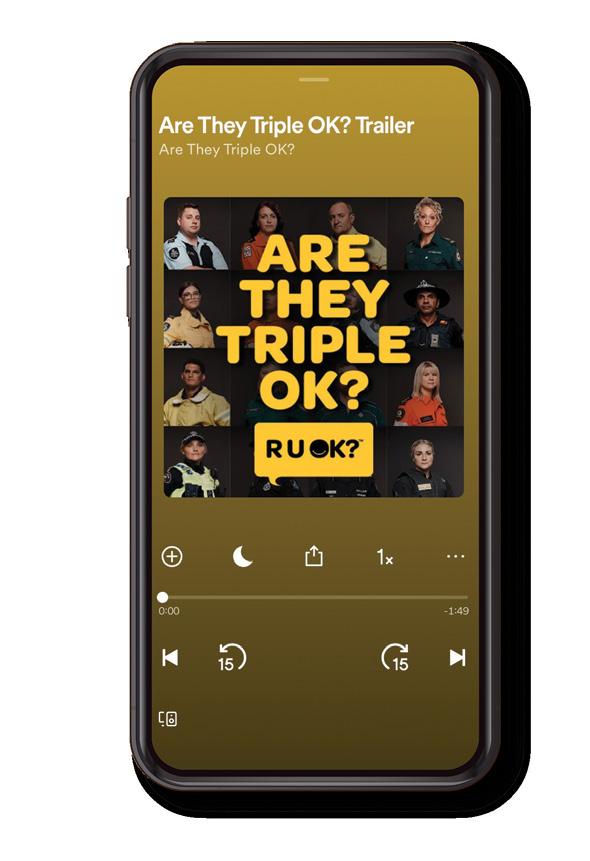

Even the most resilient emergency services workers and volunteers can be affected by stress and trauma related to their work, or as a result of other life challenges. Are They Triple OK? resources provide practical tools and tips on how to start an R U OK? conversation with a workmate, friend or family member in the emergency services, to help them feel connected and supported, long before they’re in crisis. Scan to learn more ruok.org.au/triple-ok
